site search
online catalog
MISSOURI CONFEDERATE FROCK COAT, SASH, CS SWORD BELT, AND HOLSTER, OF MAJOR WILLIAM F. HAINES, WITH FAMILY ARCHIVE OF PHOTOS & PAPERS: SHILOH, VICKSBURG, AND NEGOTIATIONS WITH SHERMAN FOR SURRENDER OF GEN. L.S. BAKER’S COMMAND IN APRIL 1865
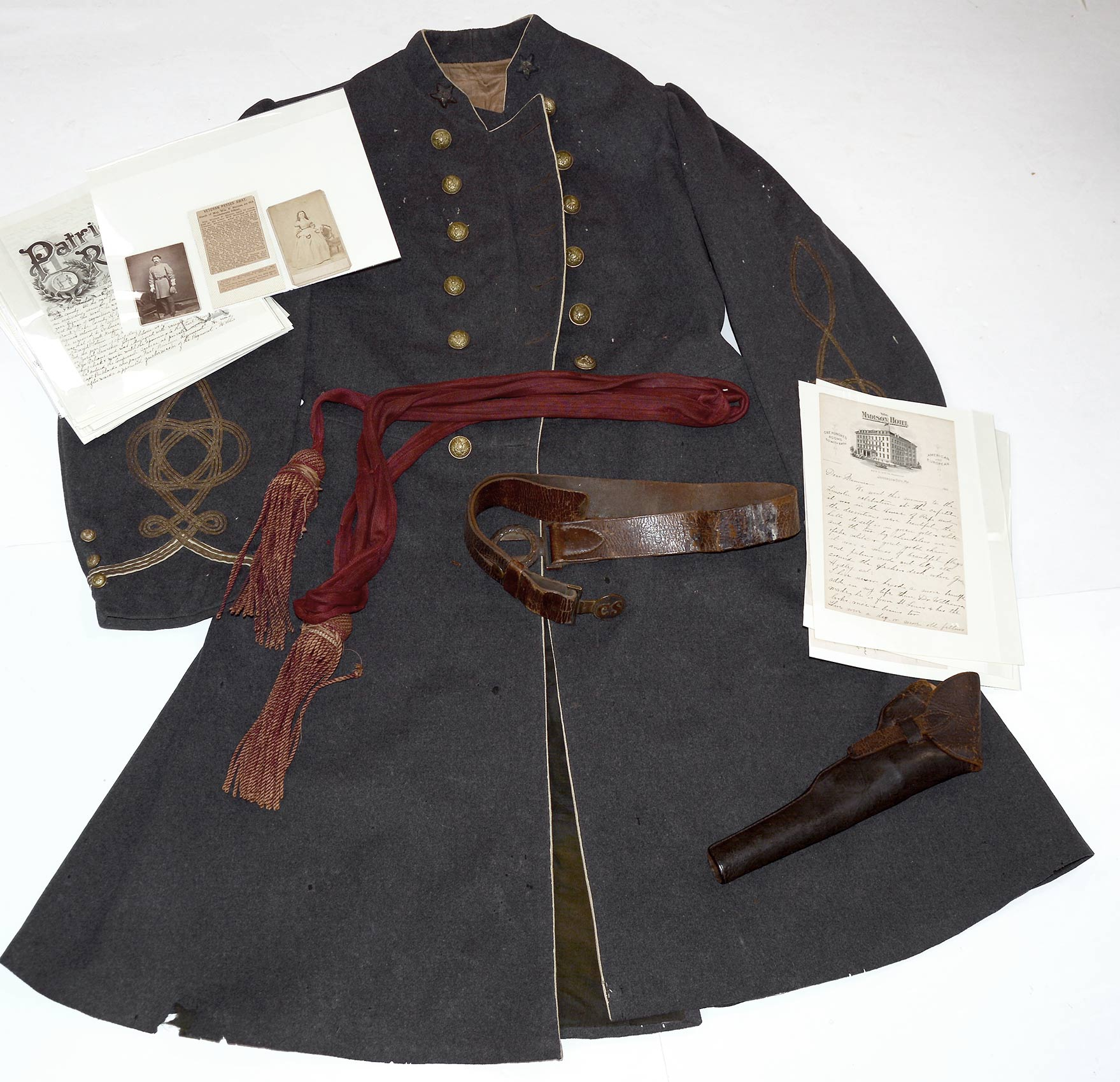
Hover to zoom

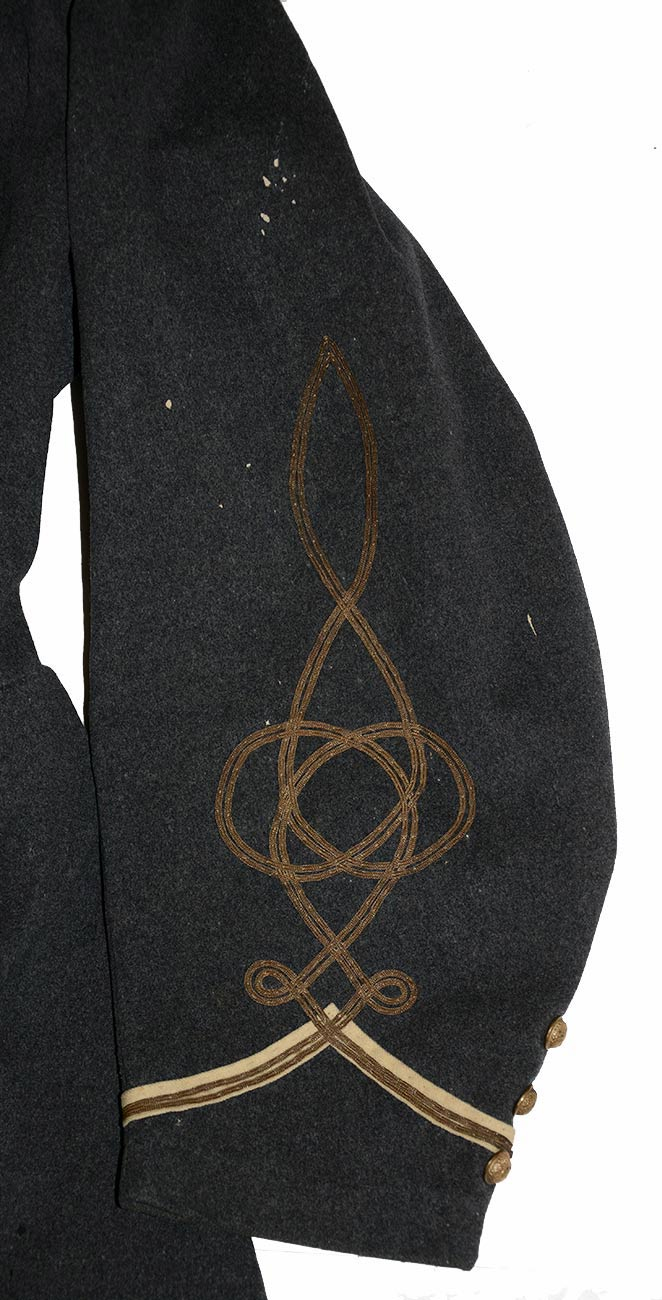
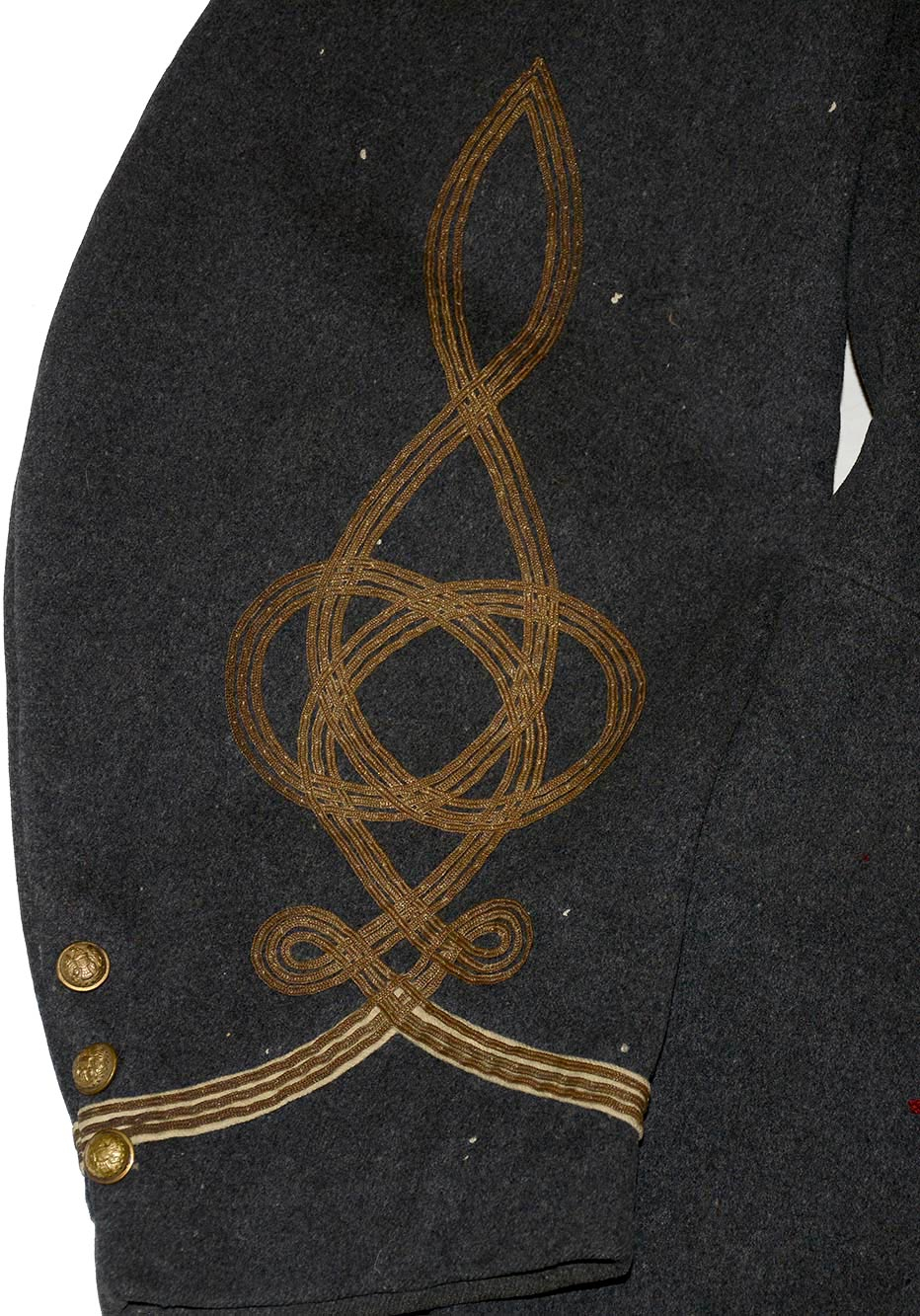
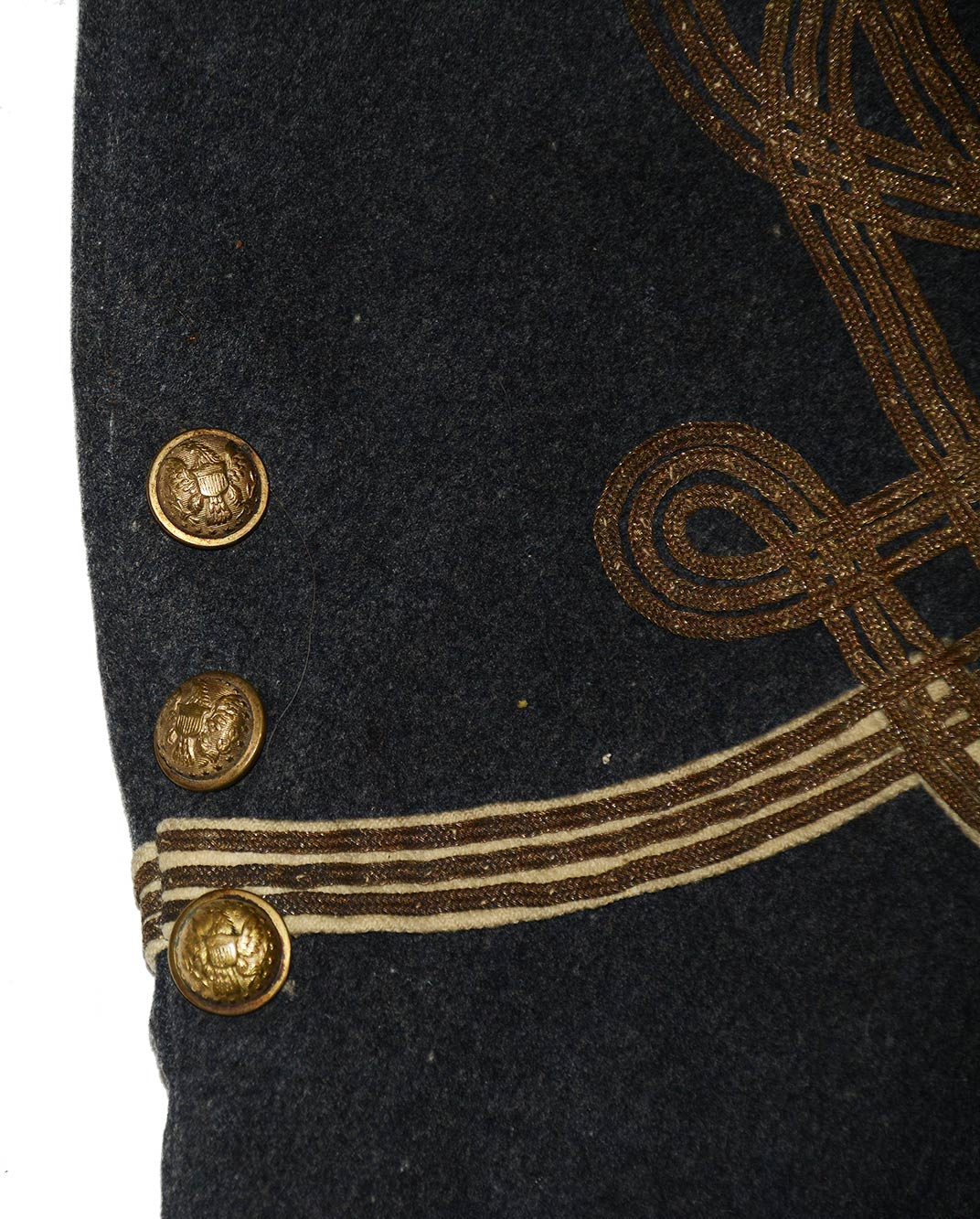
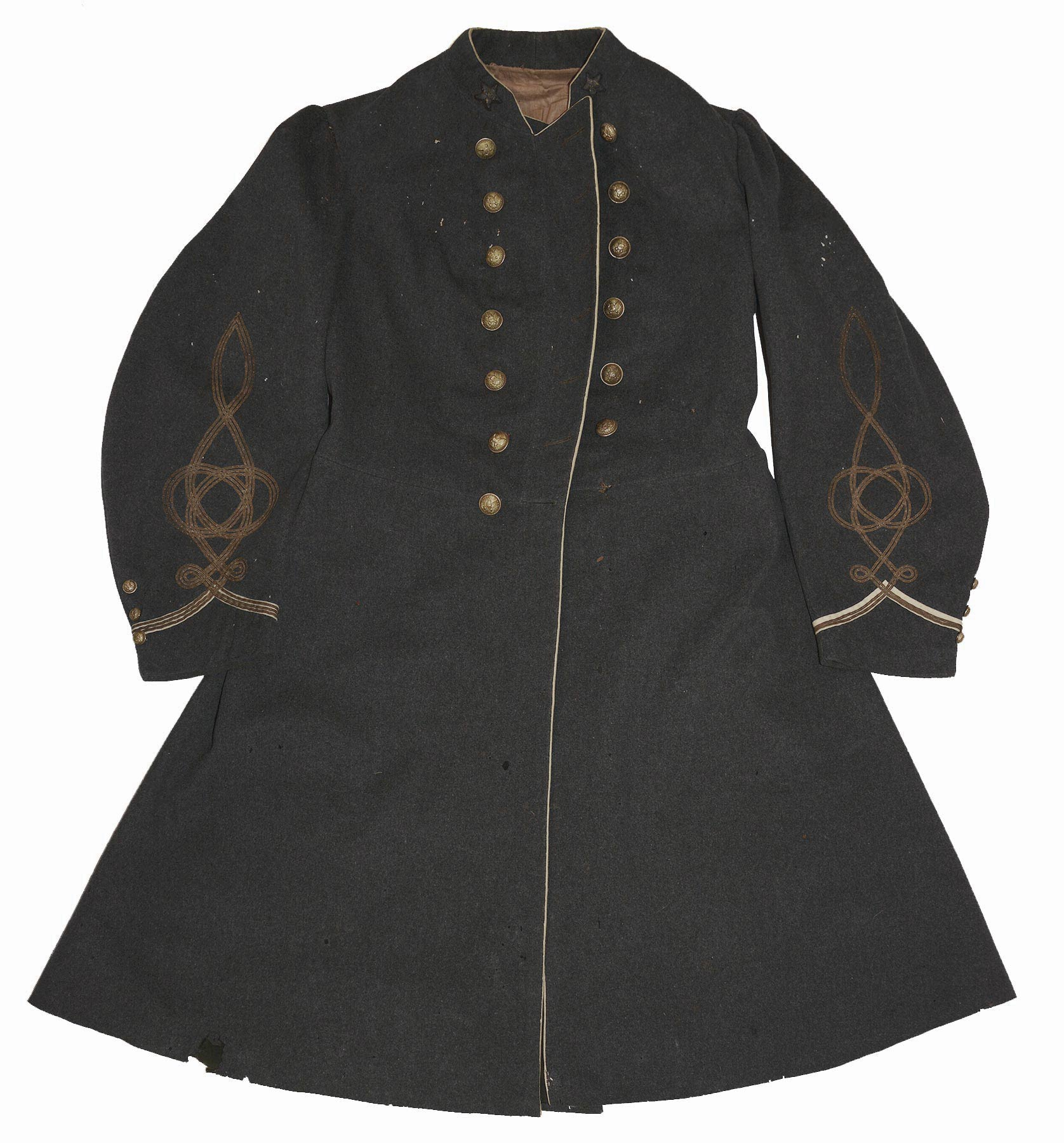
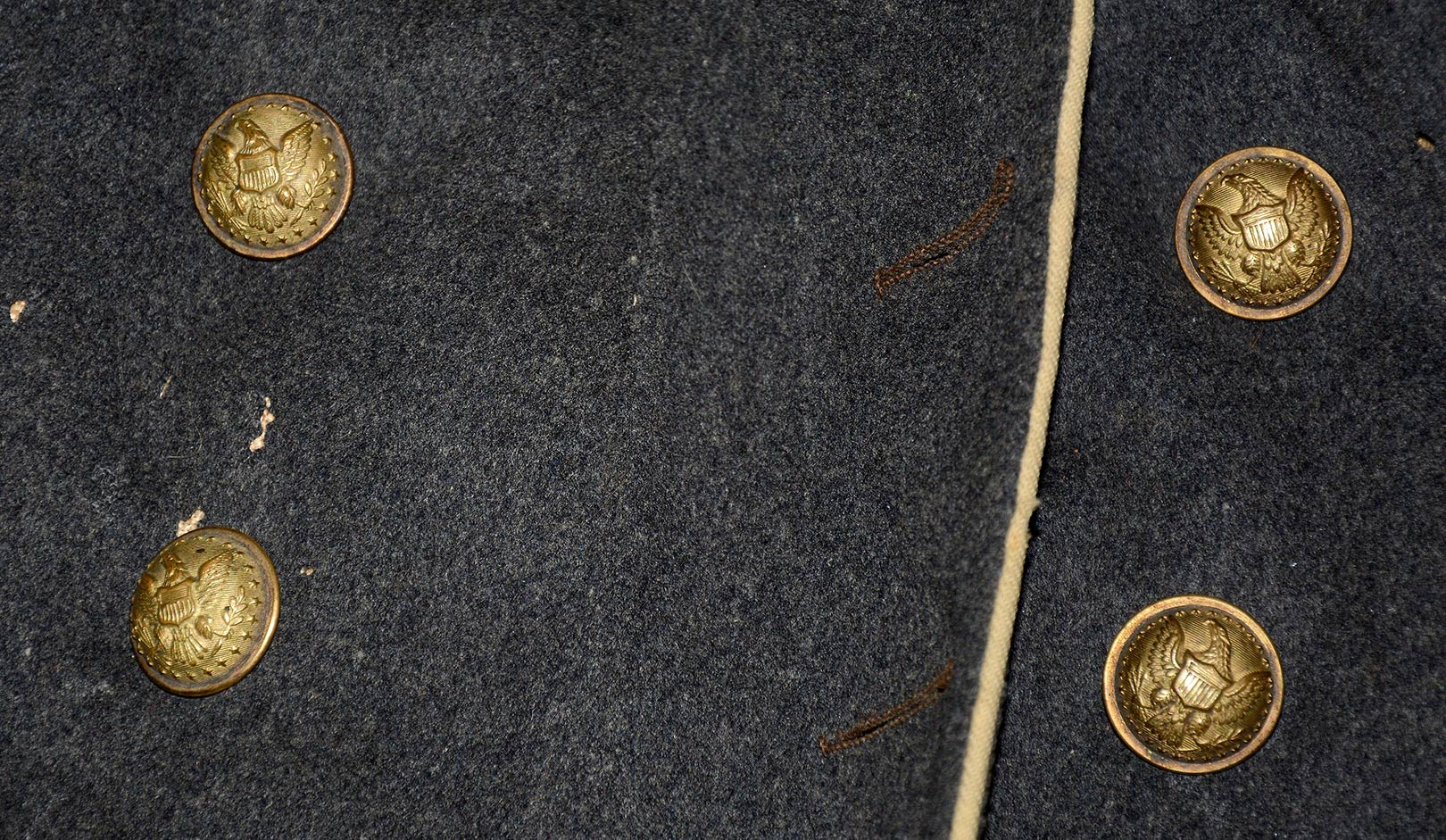
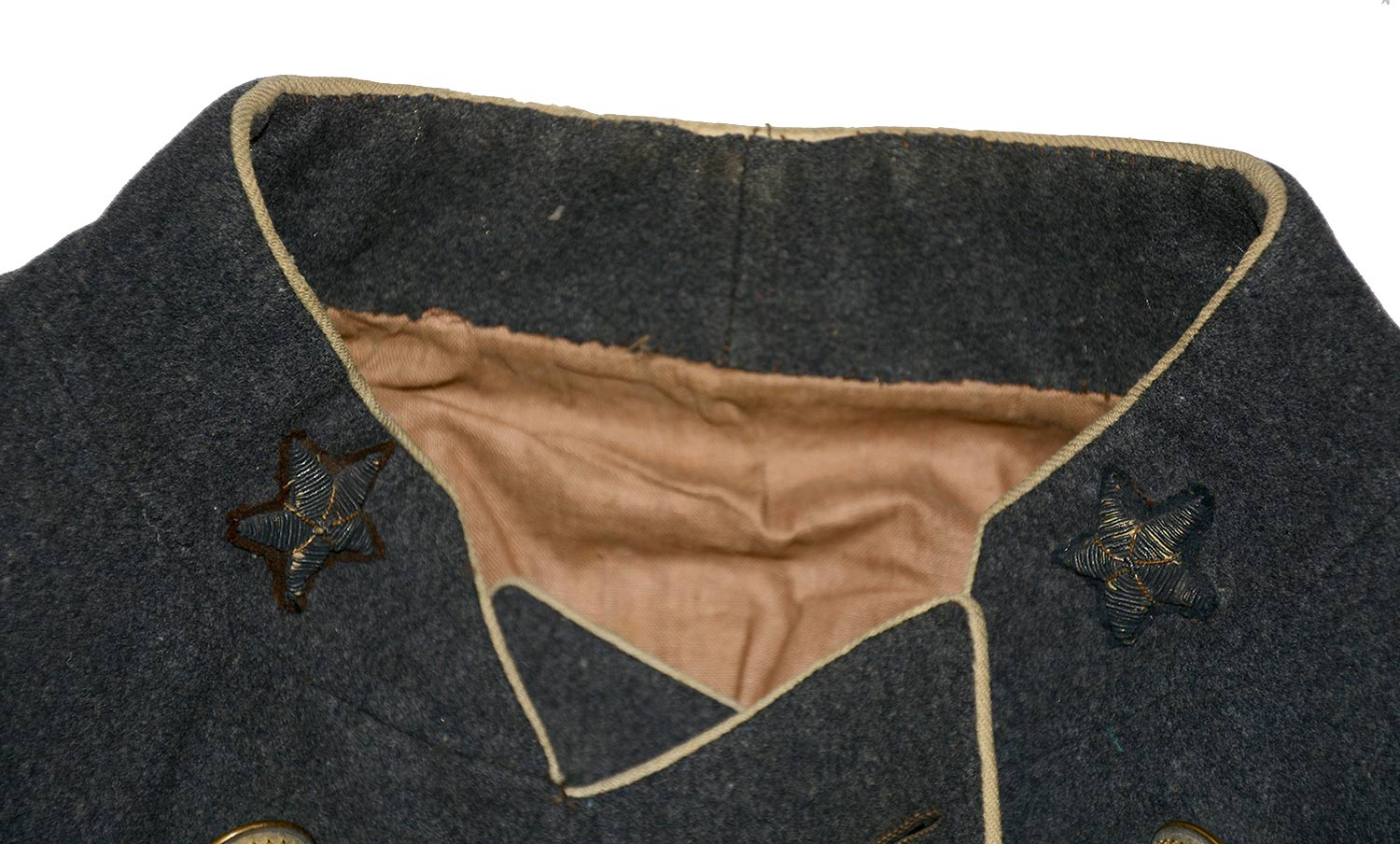

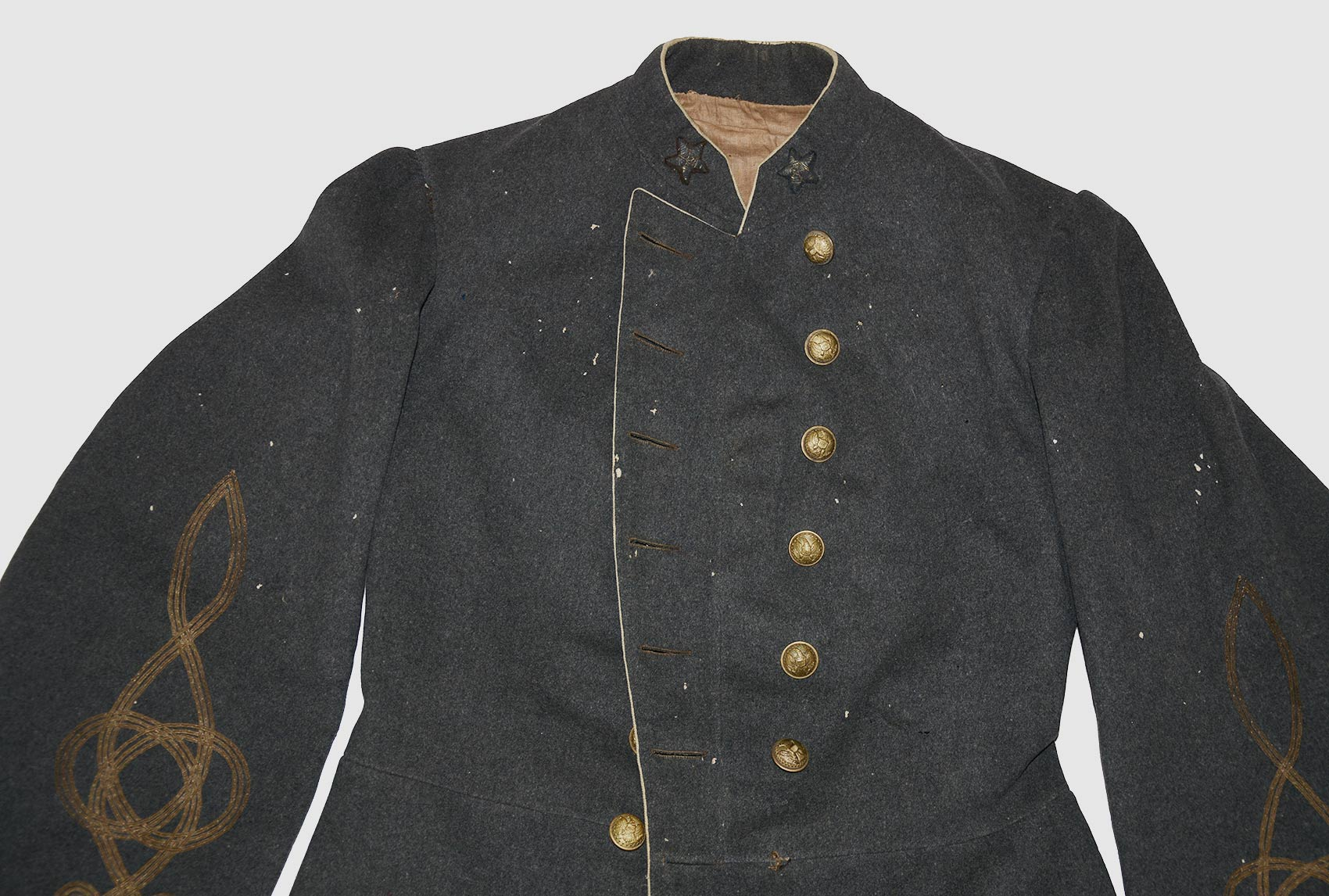
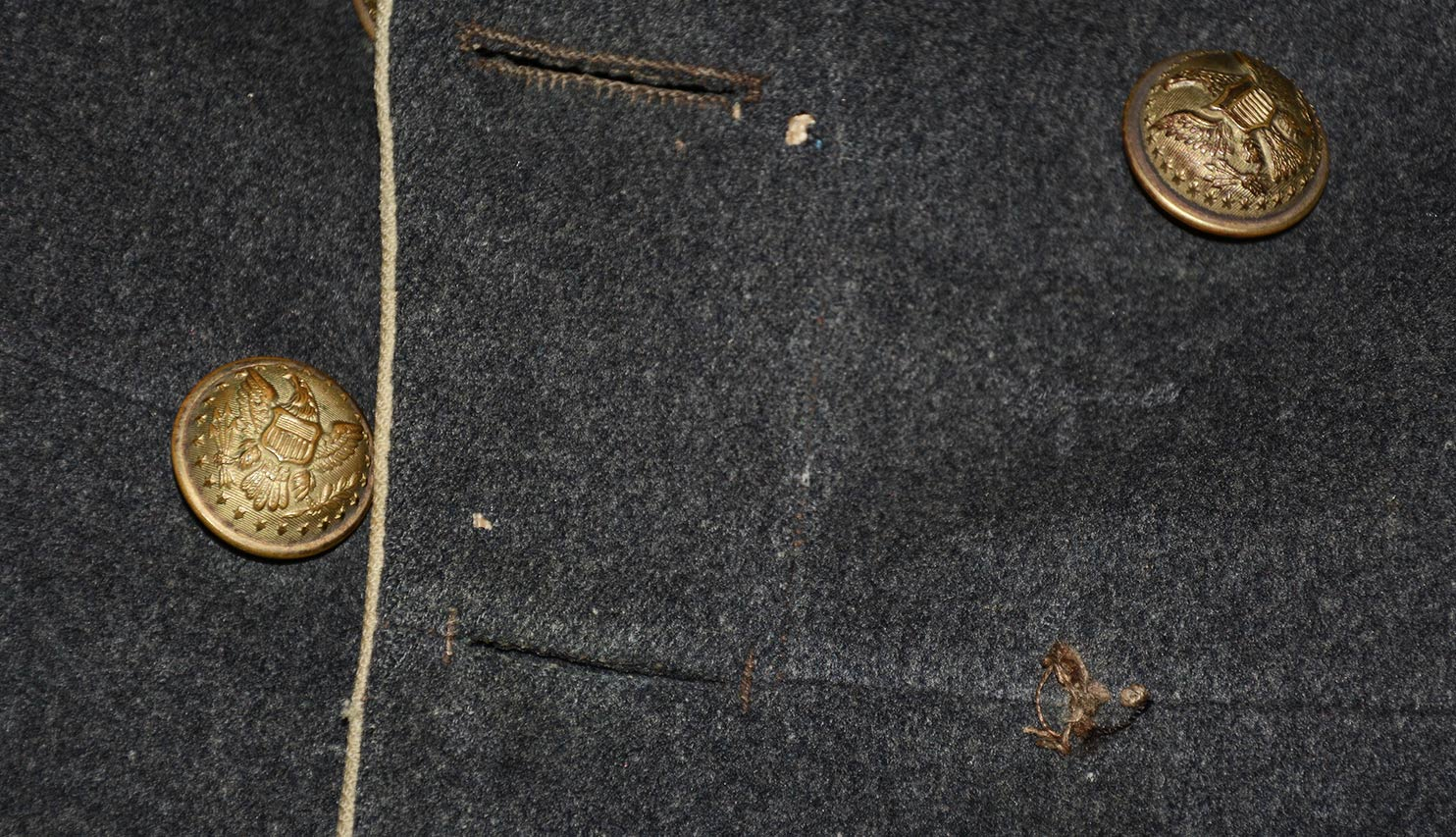
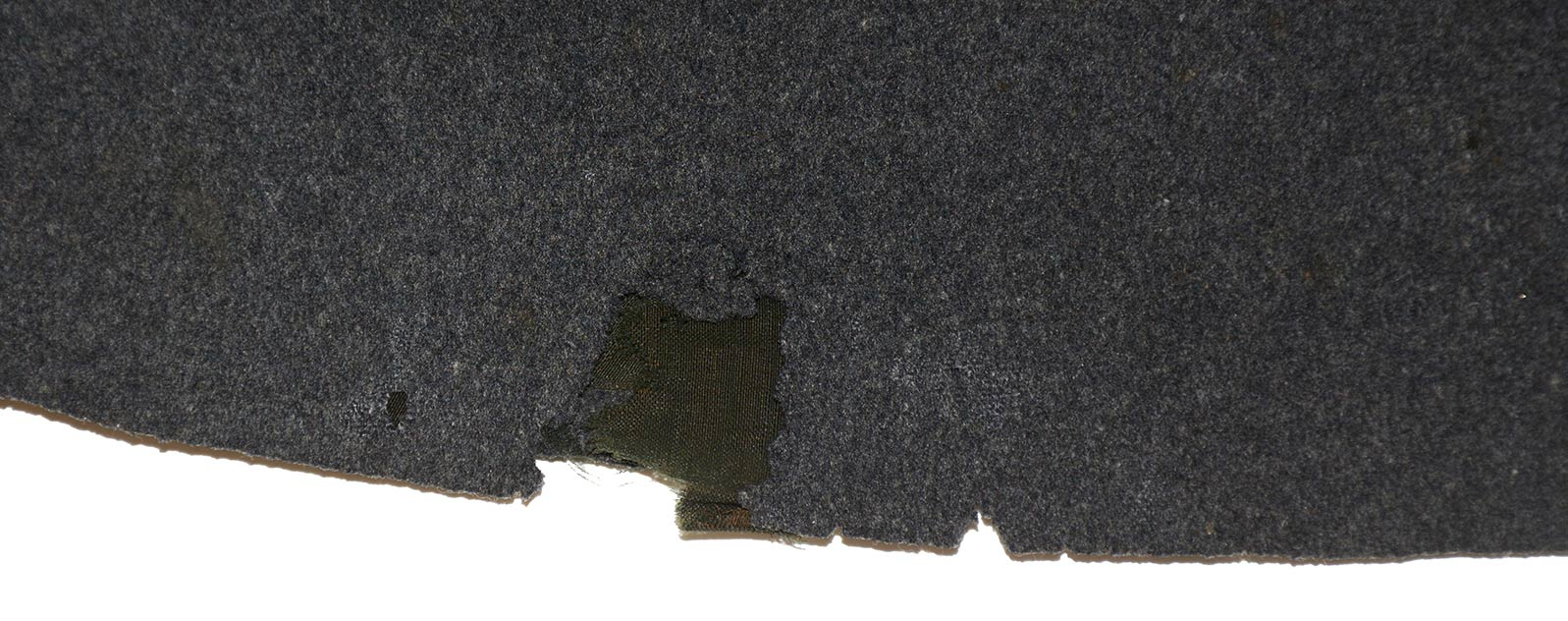
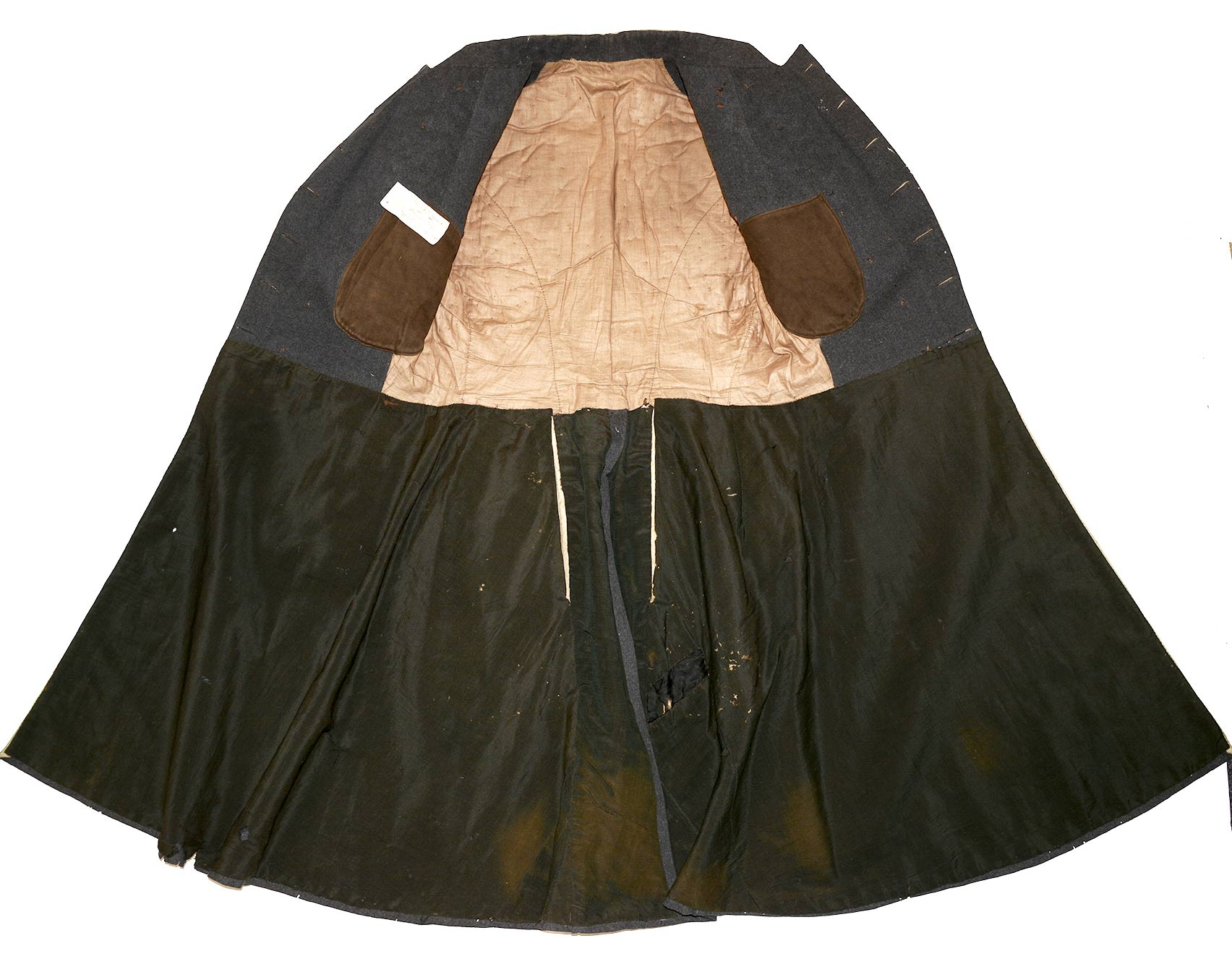
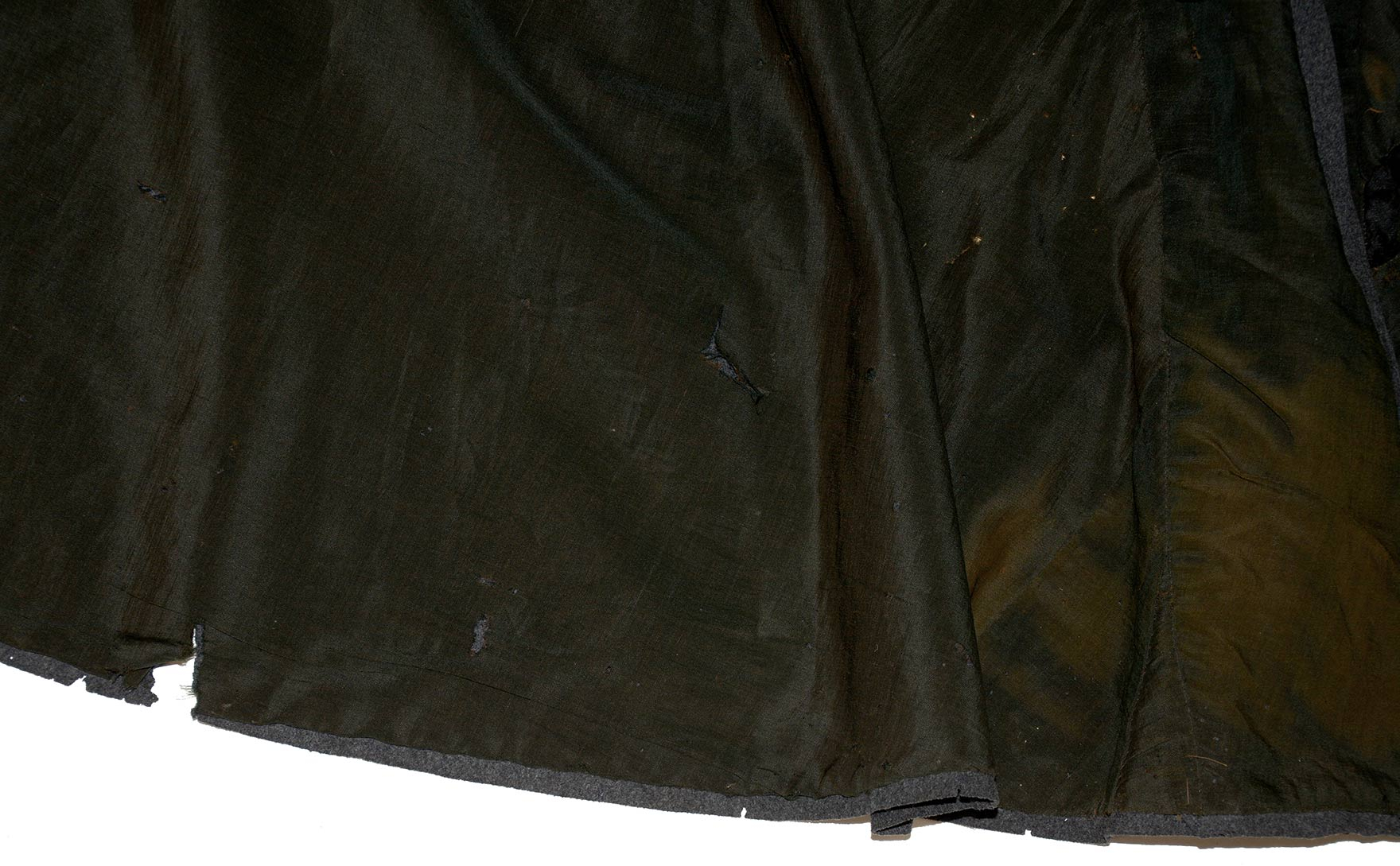
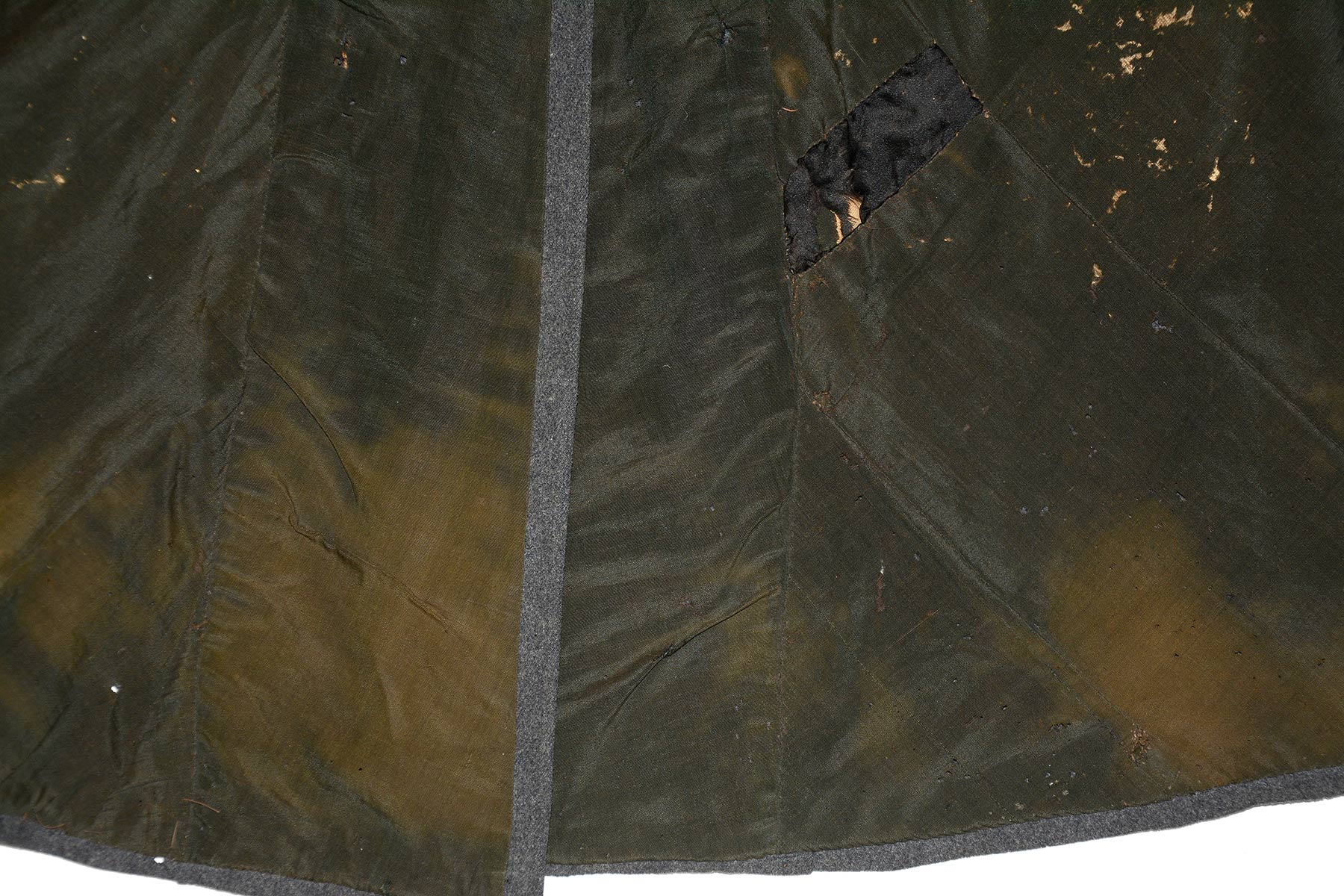
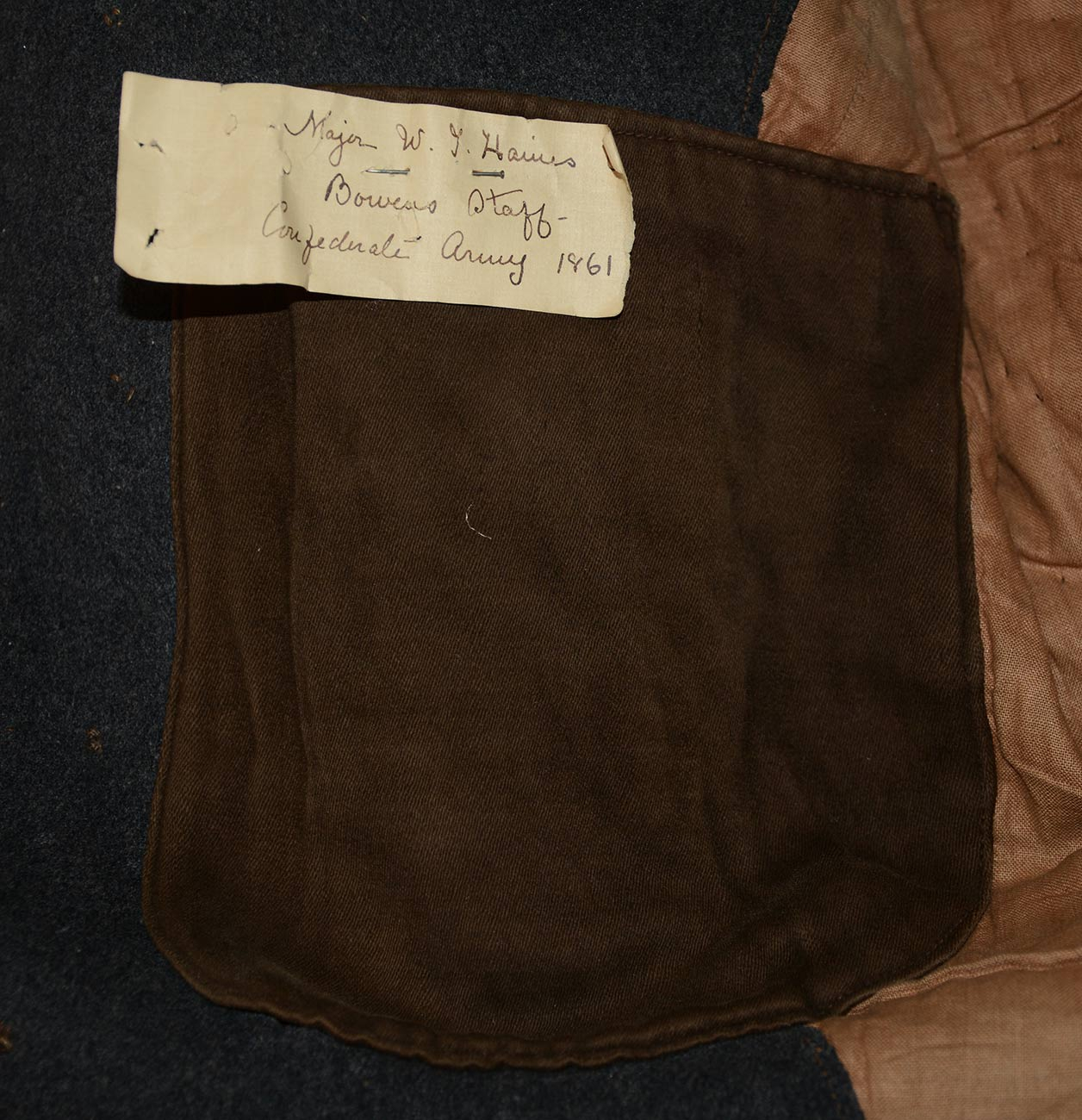
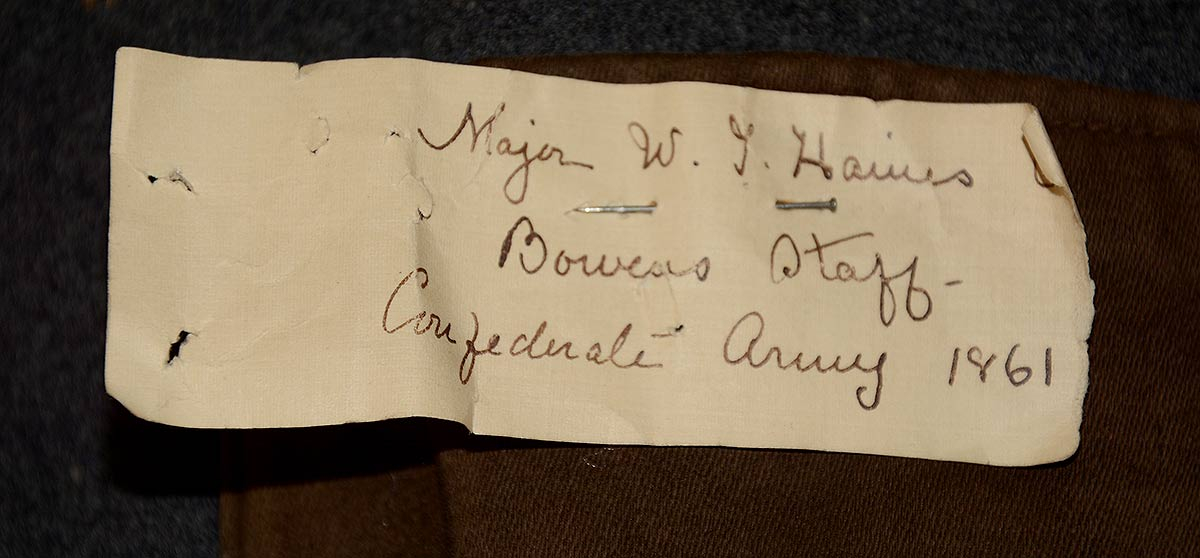
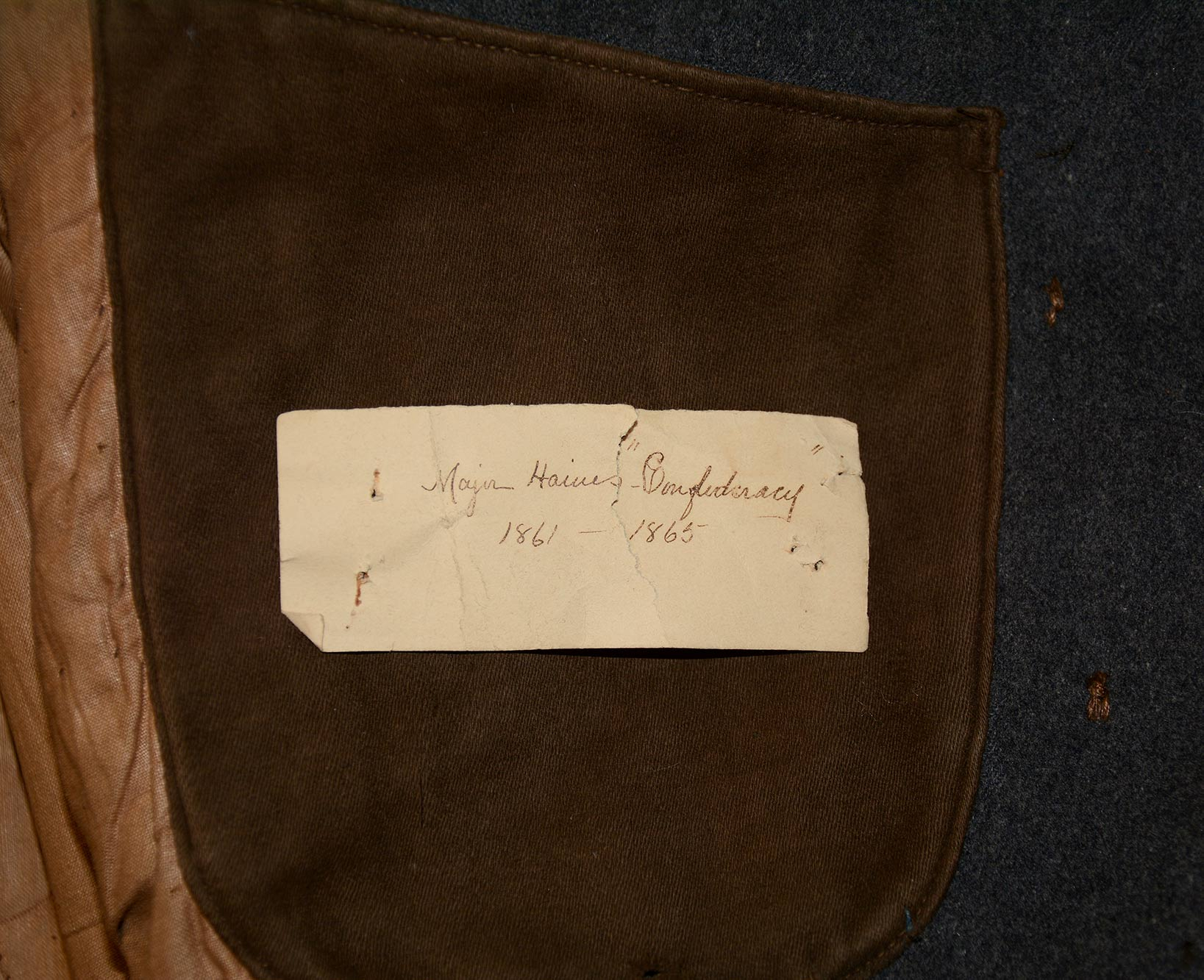
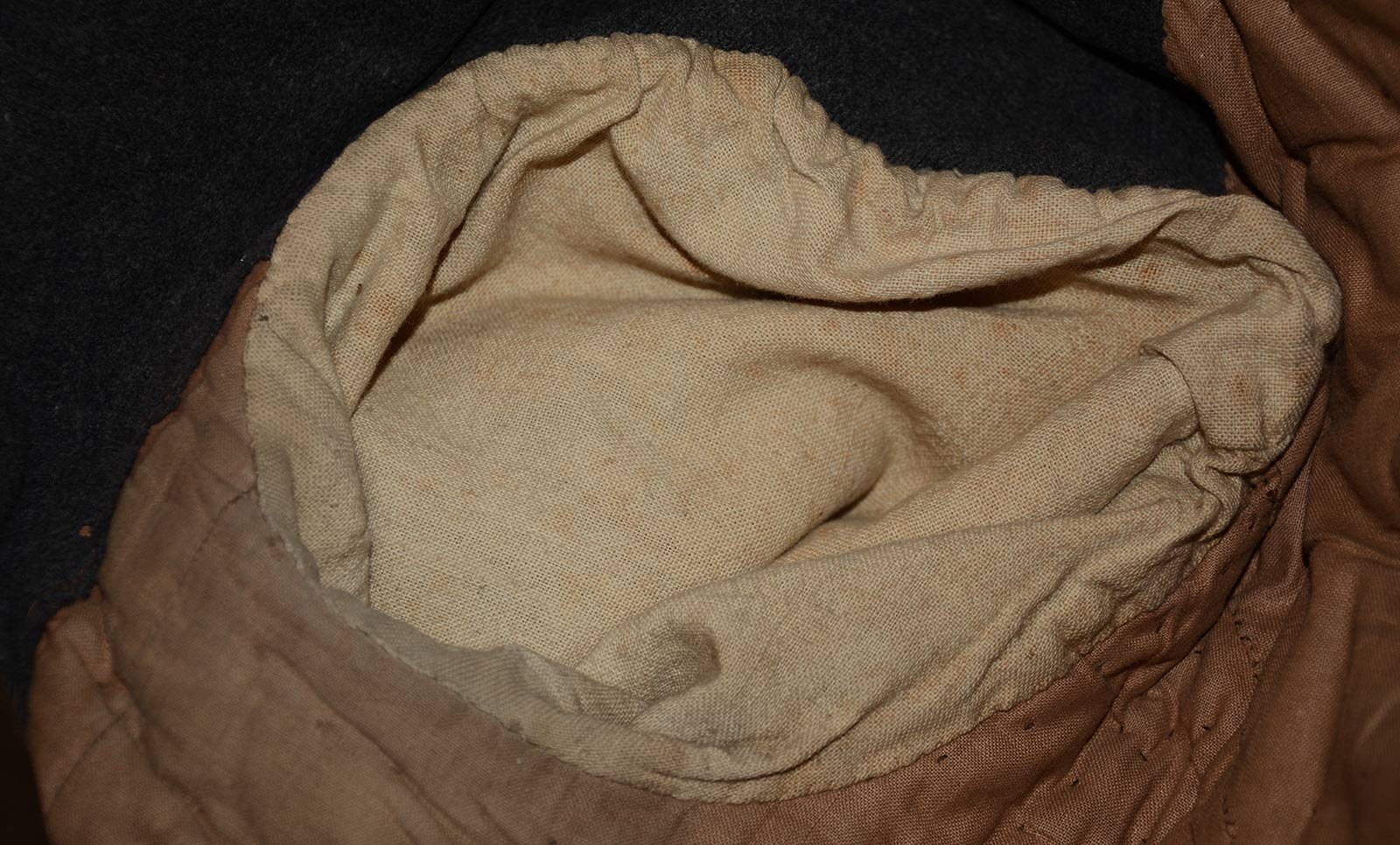
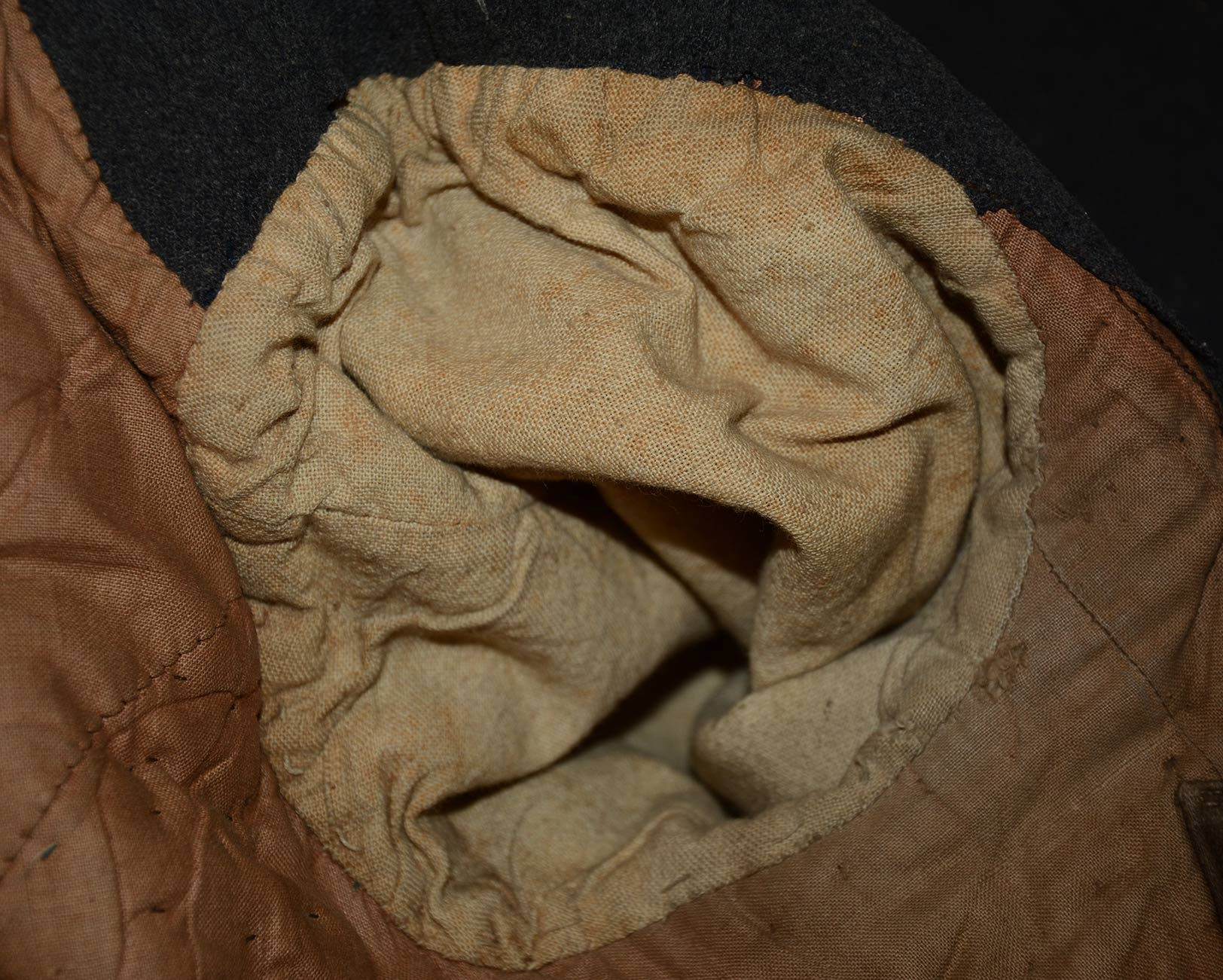
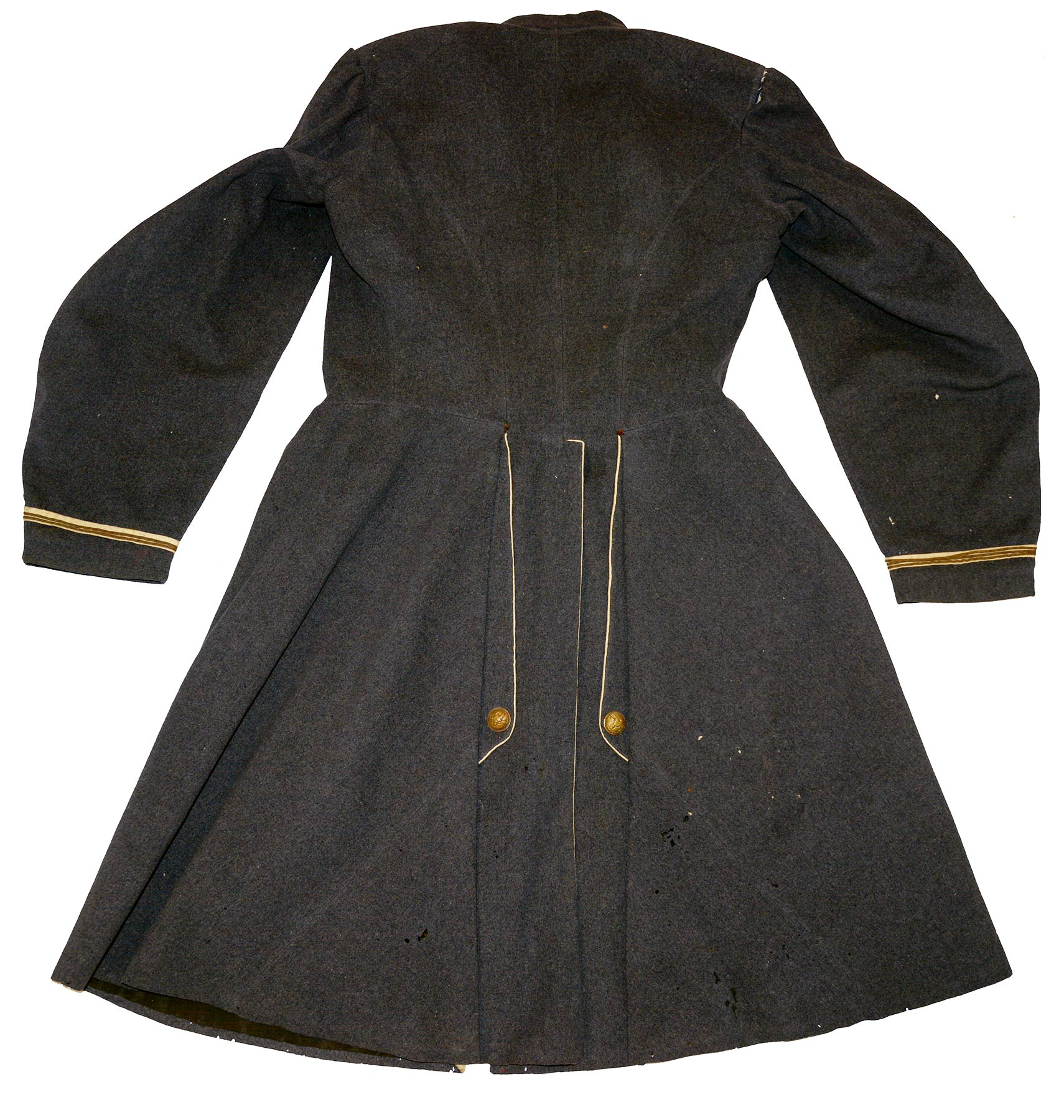
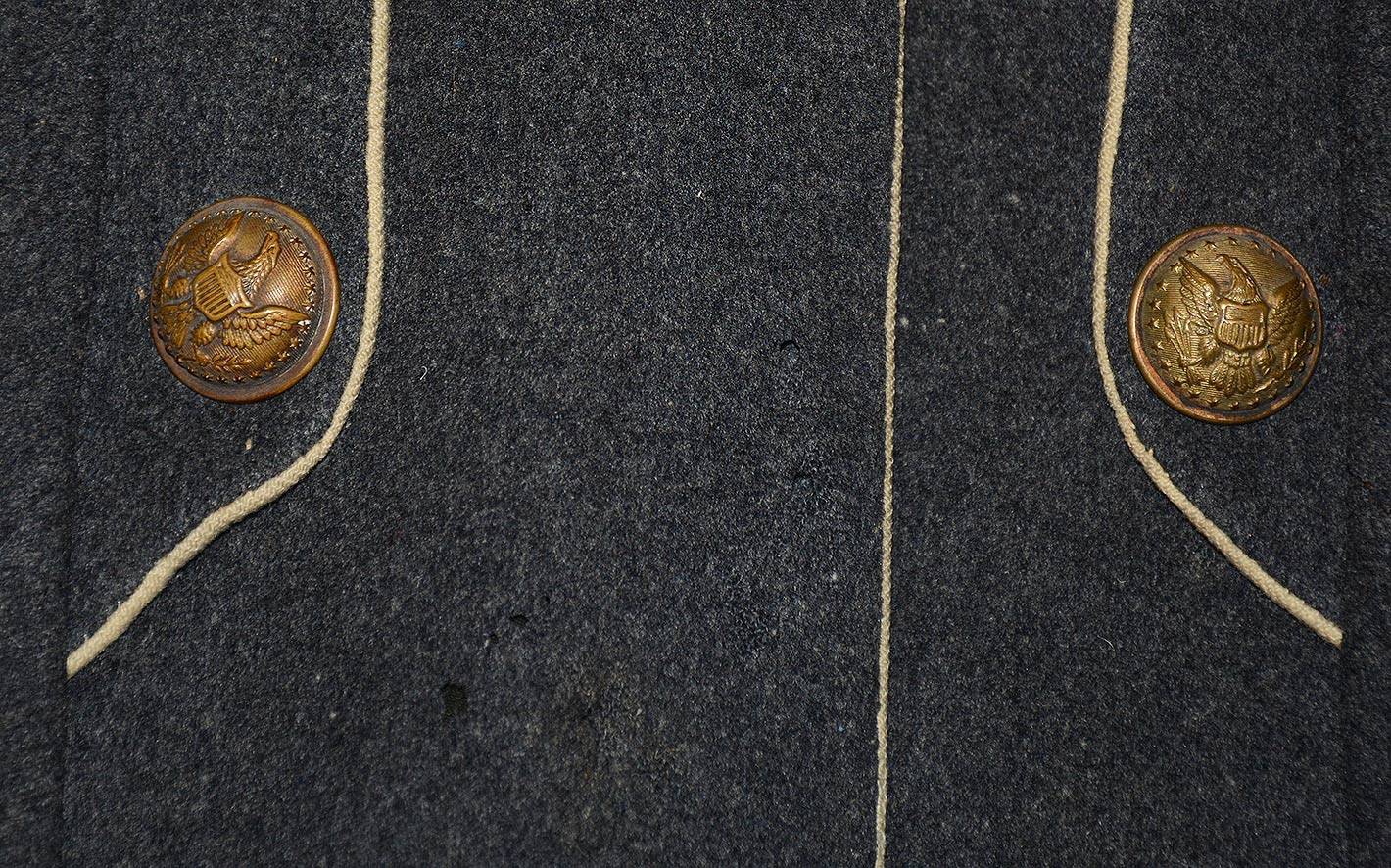
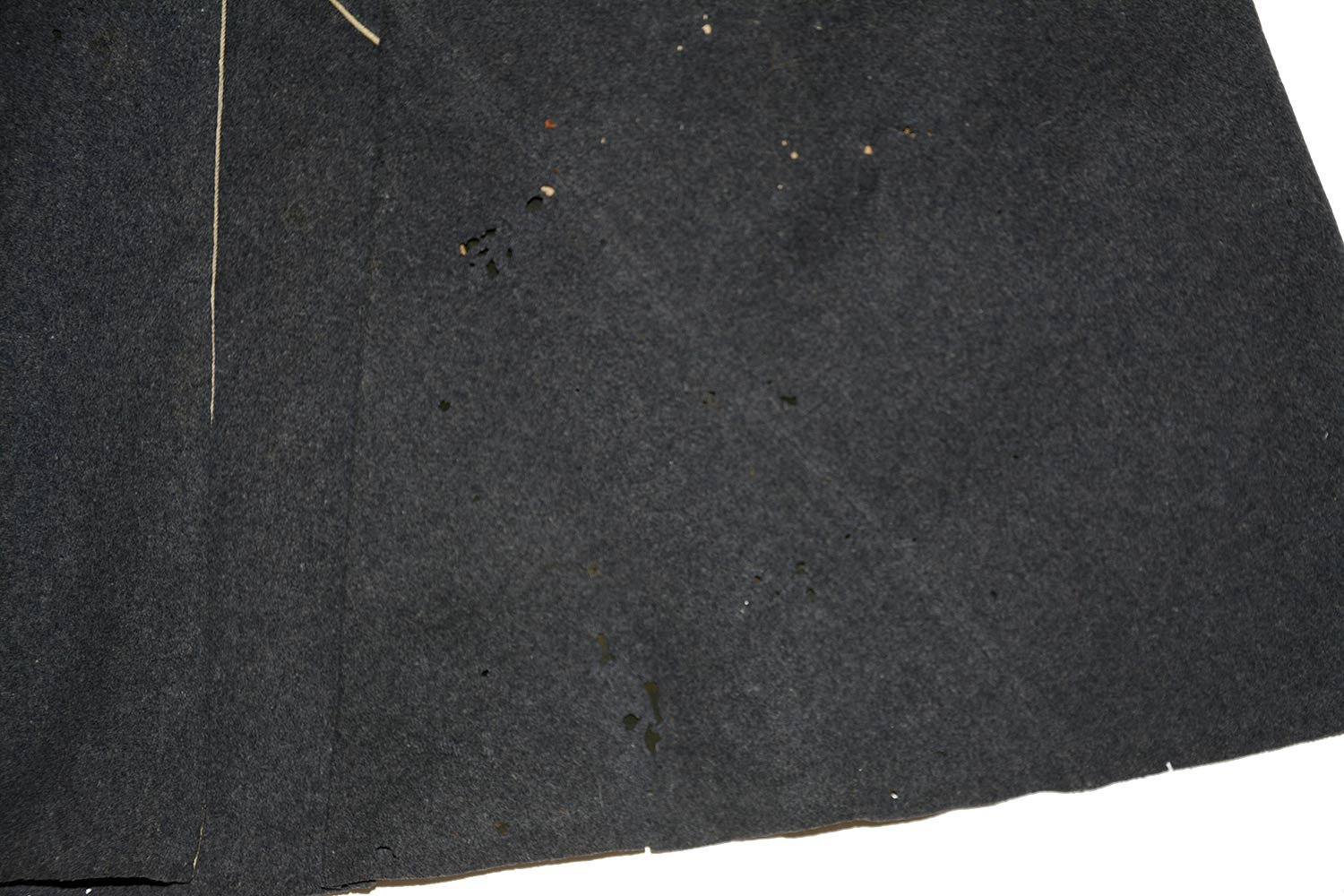
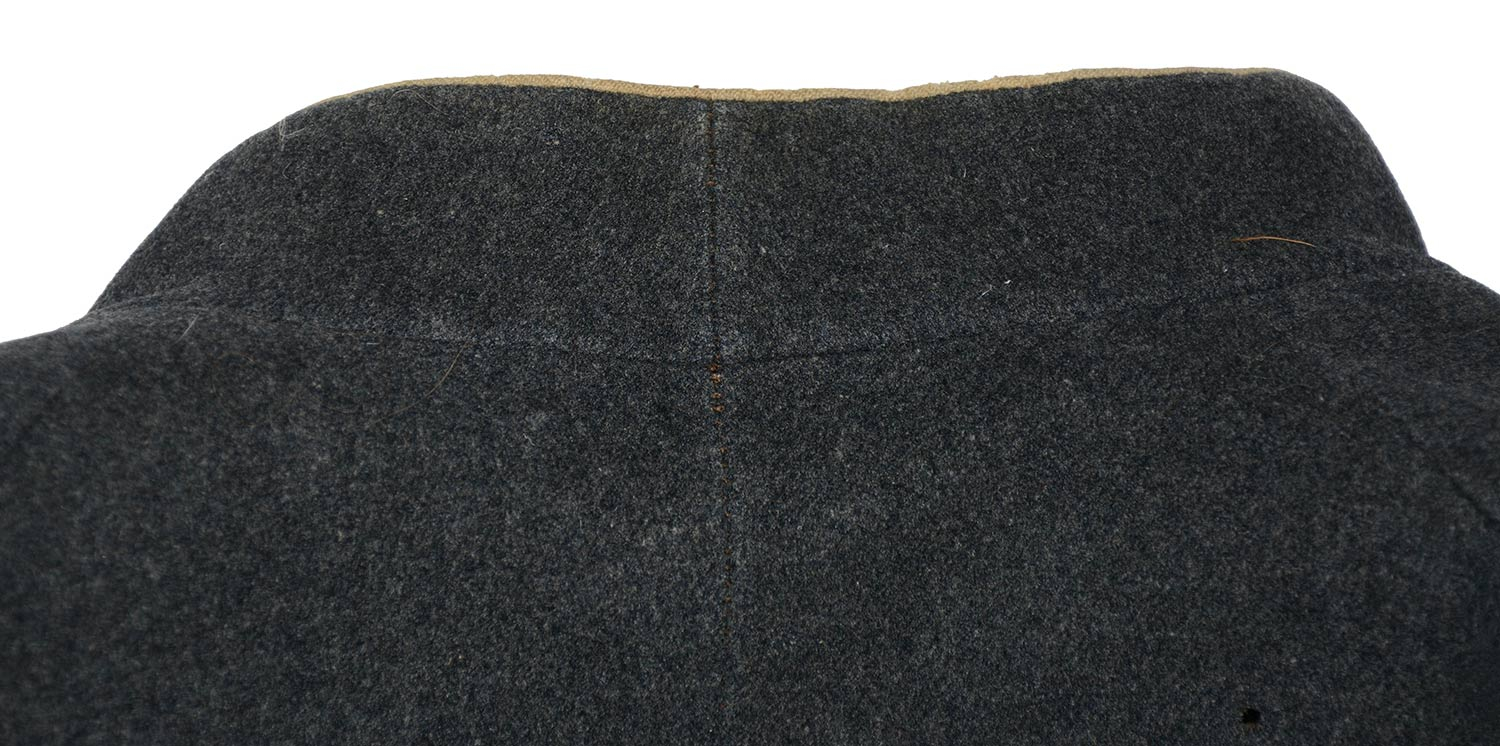
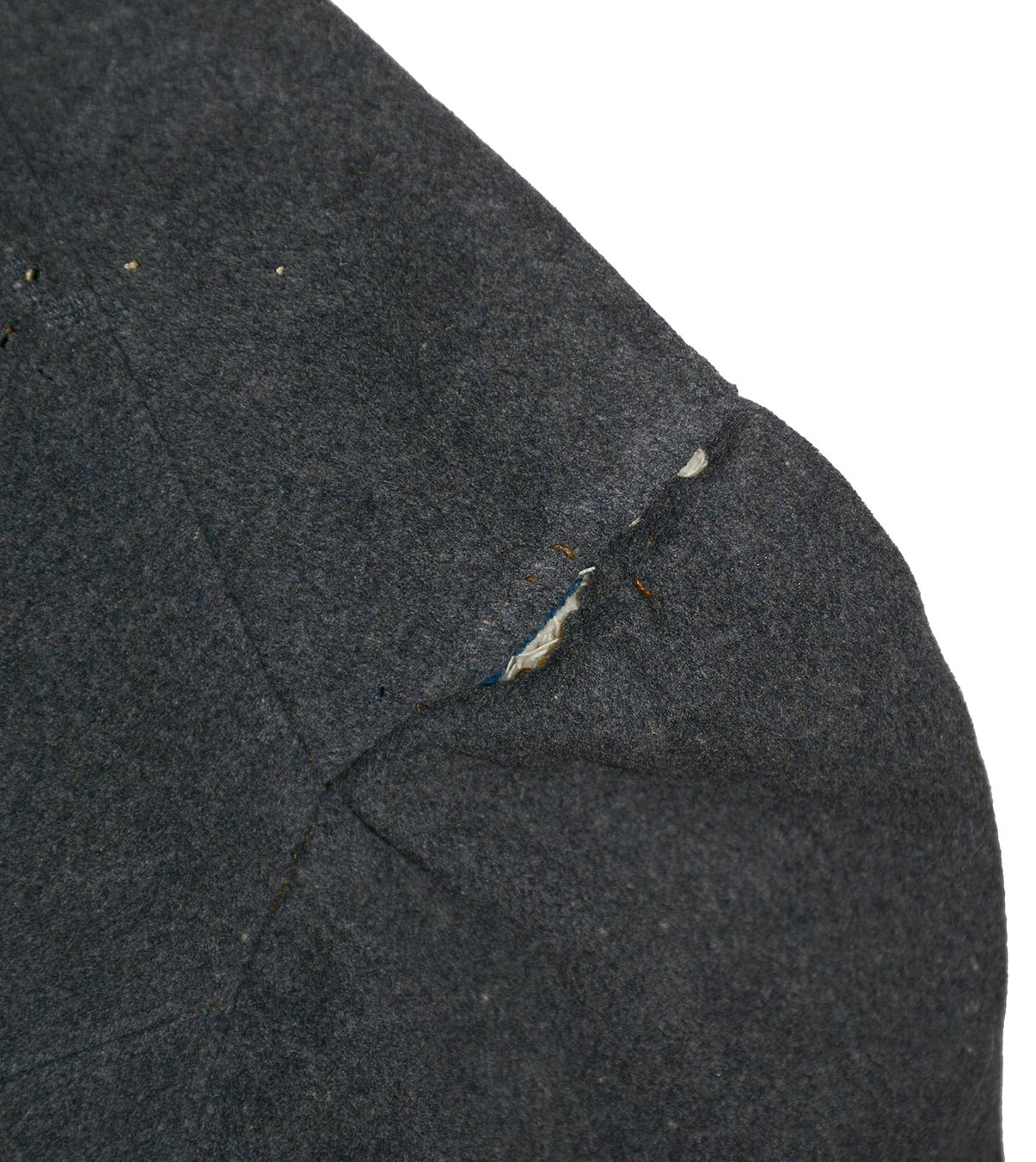

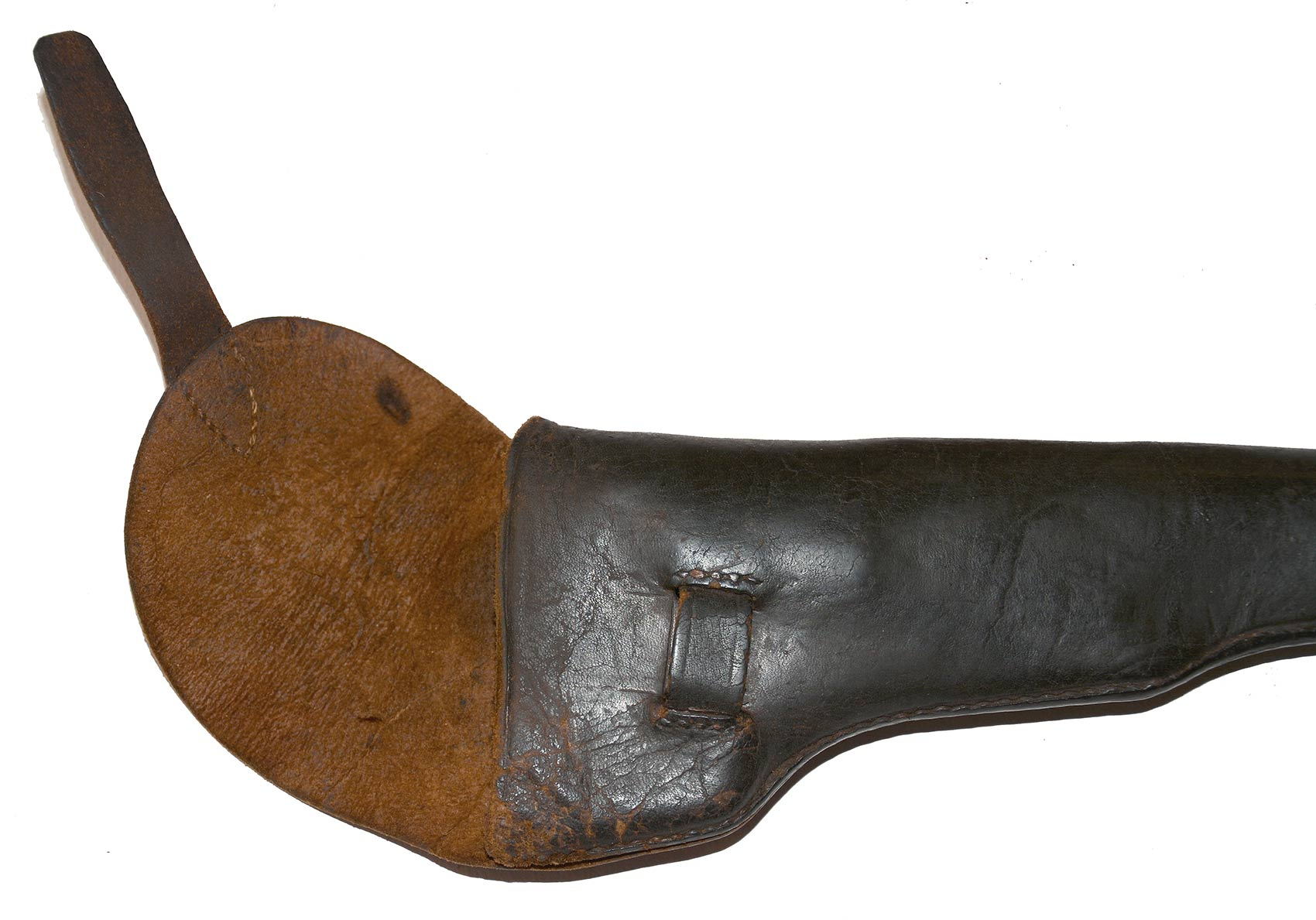
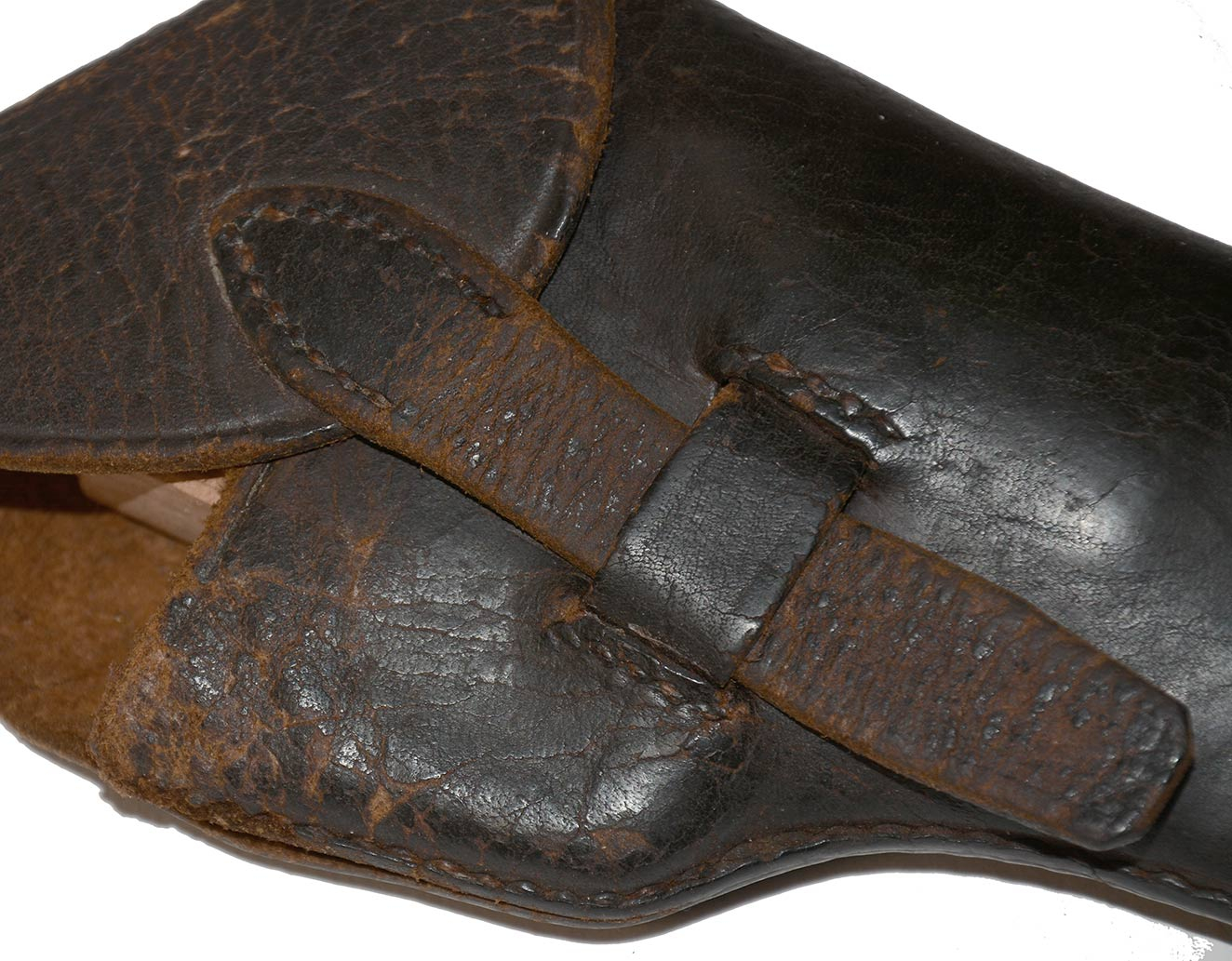
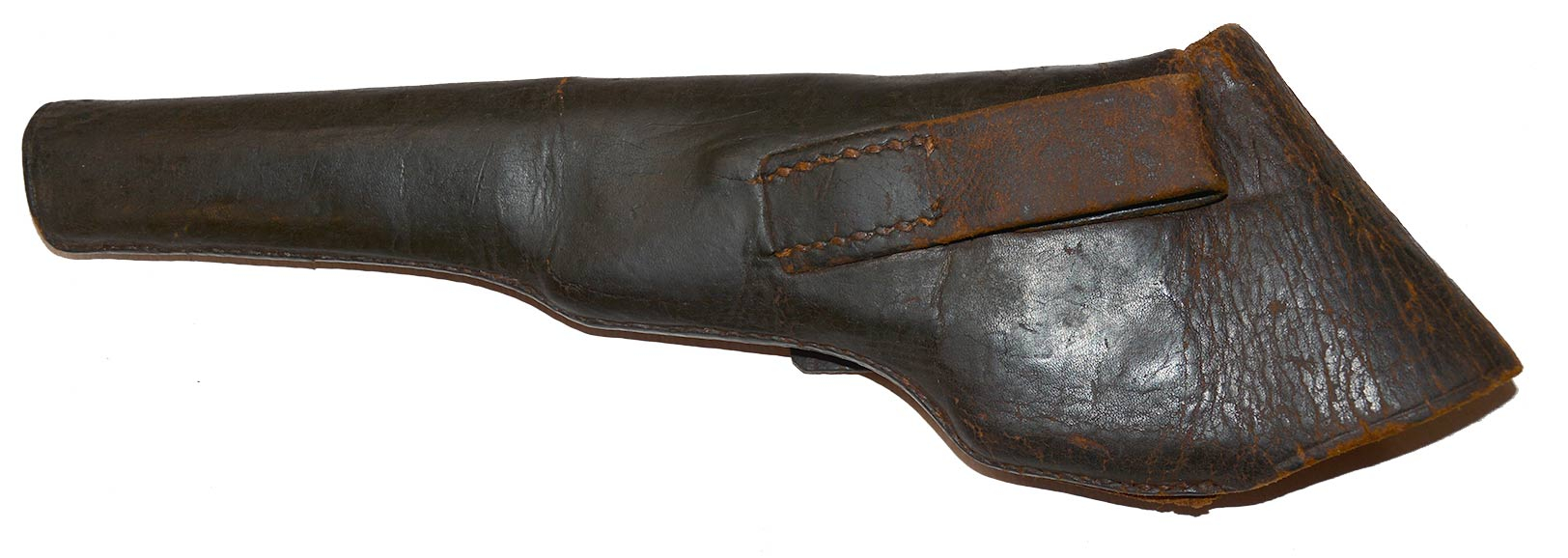
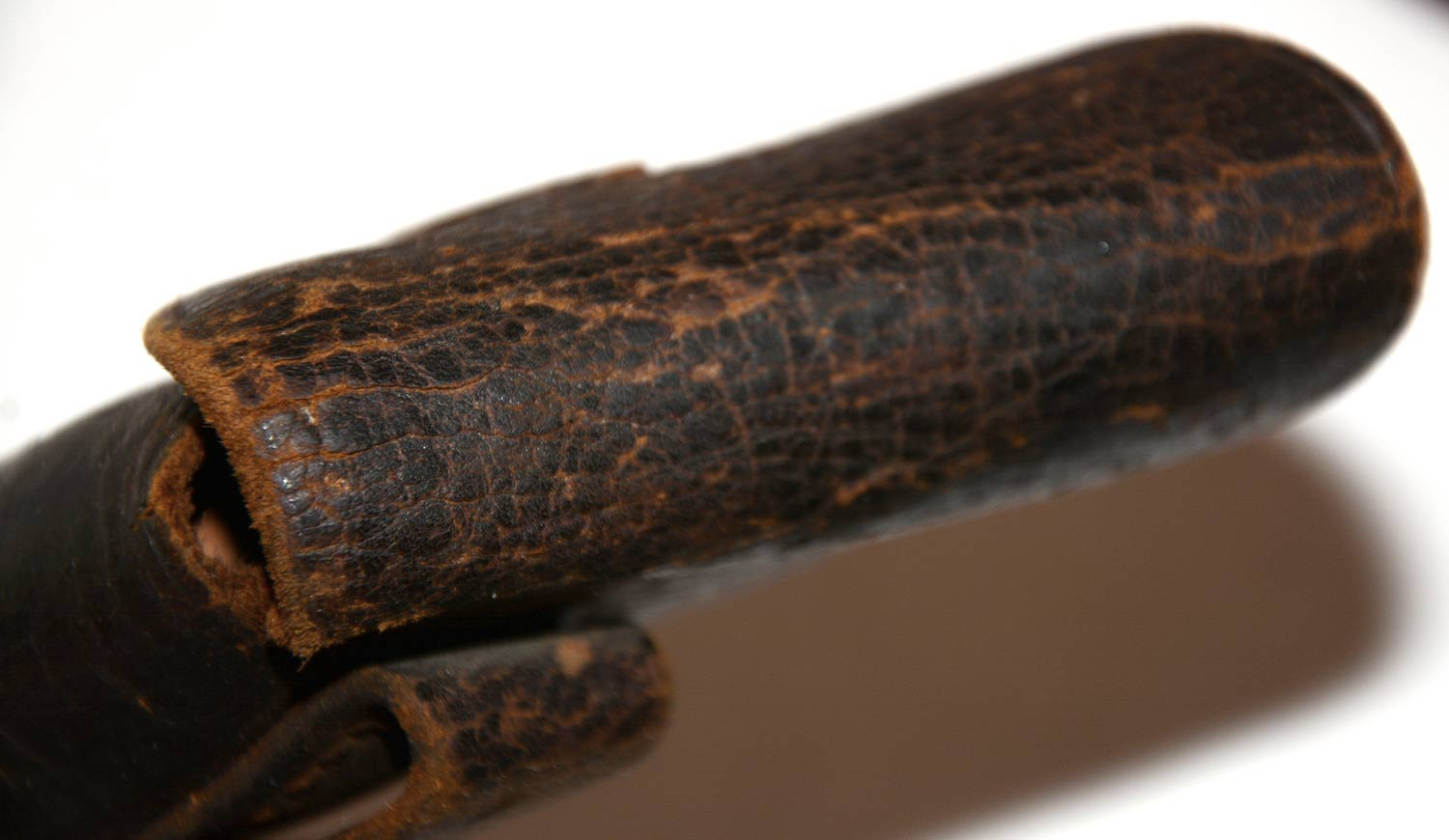
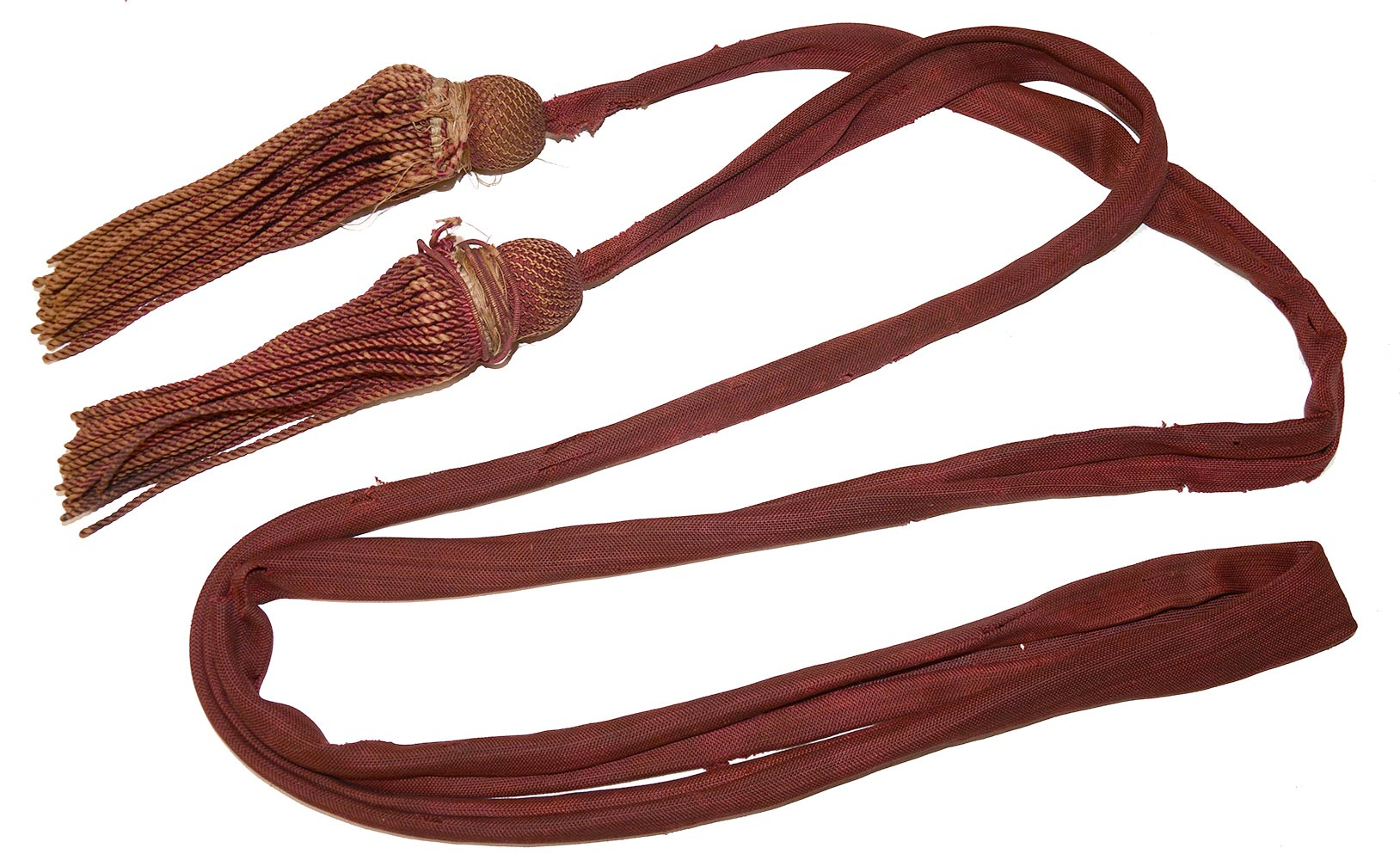
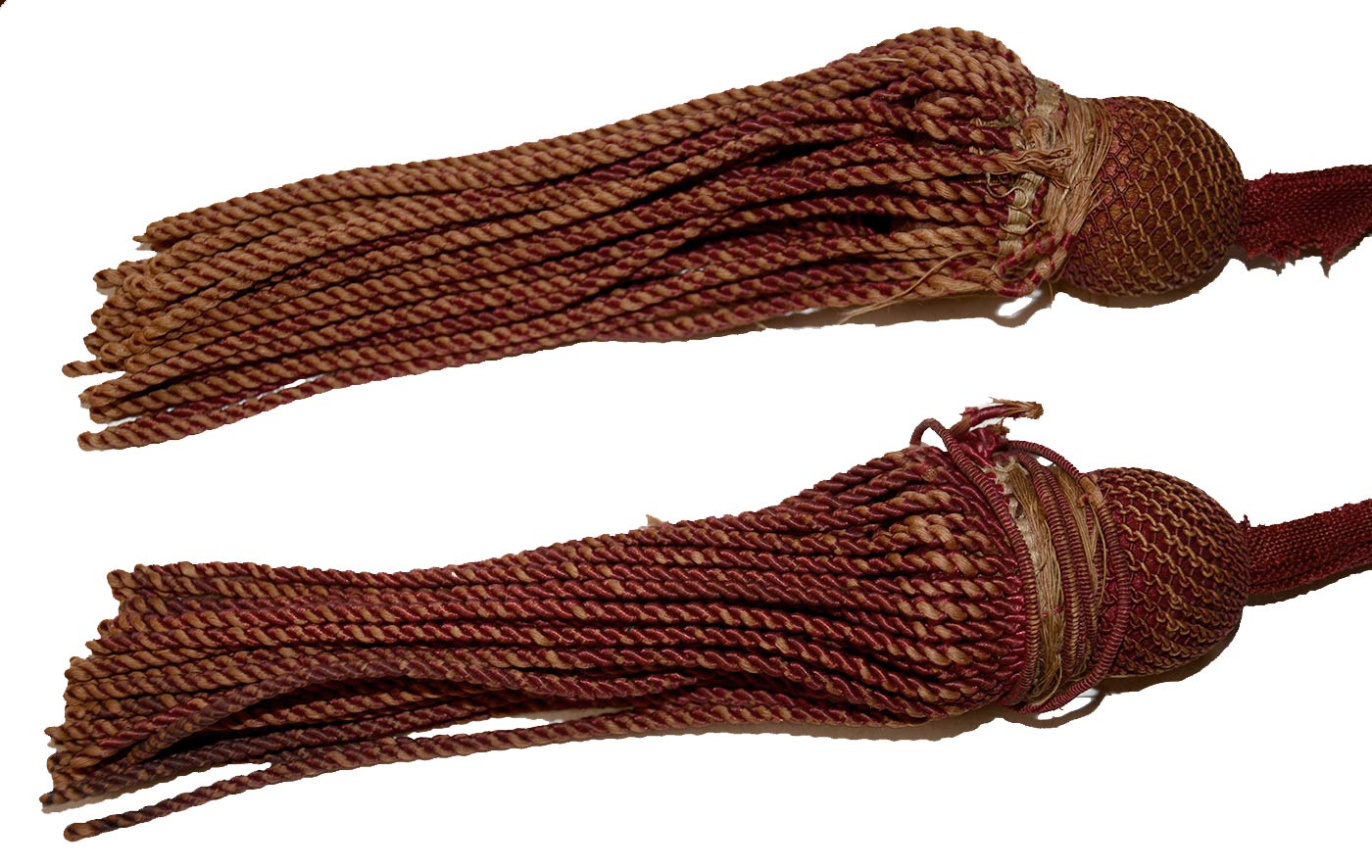

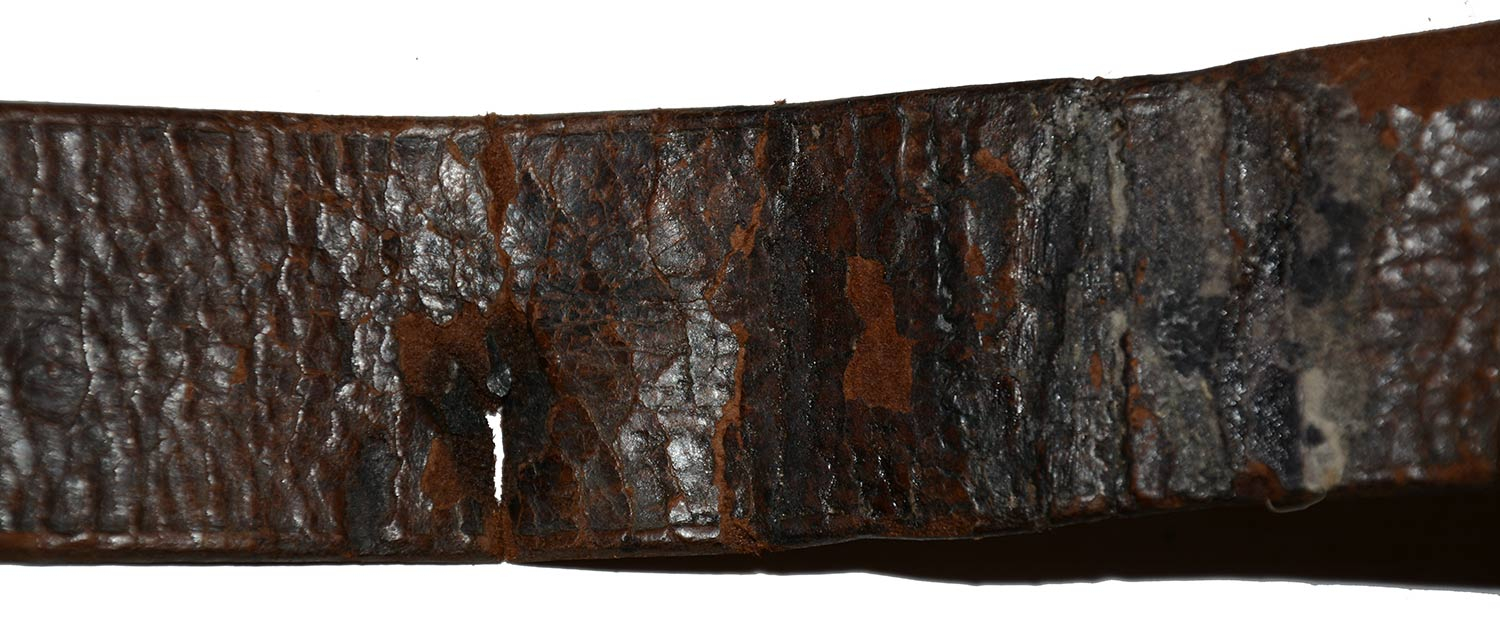
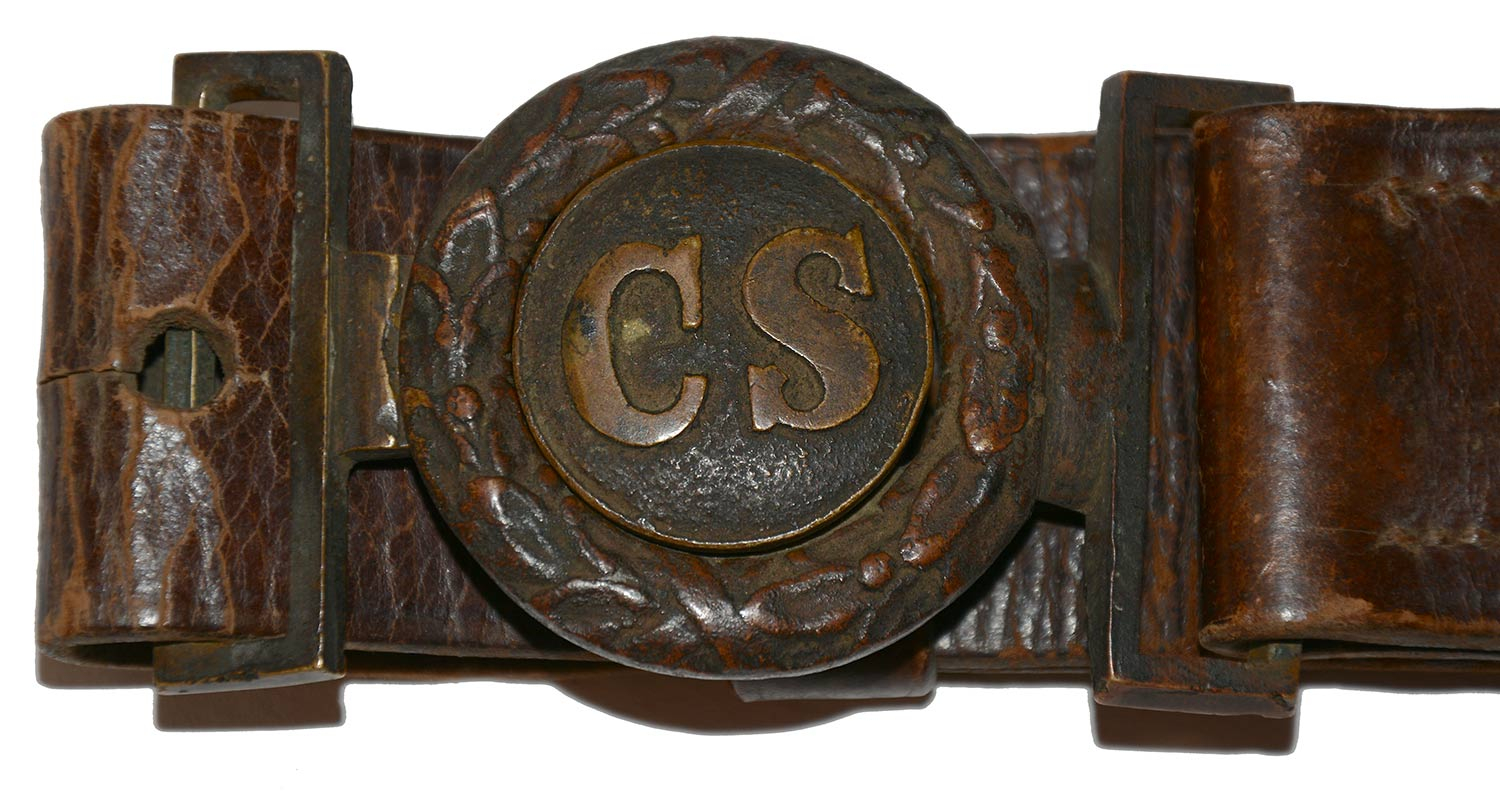
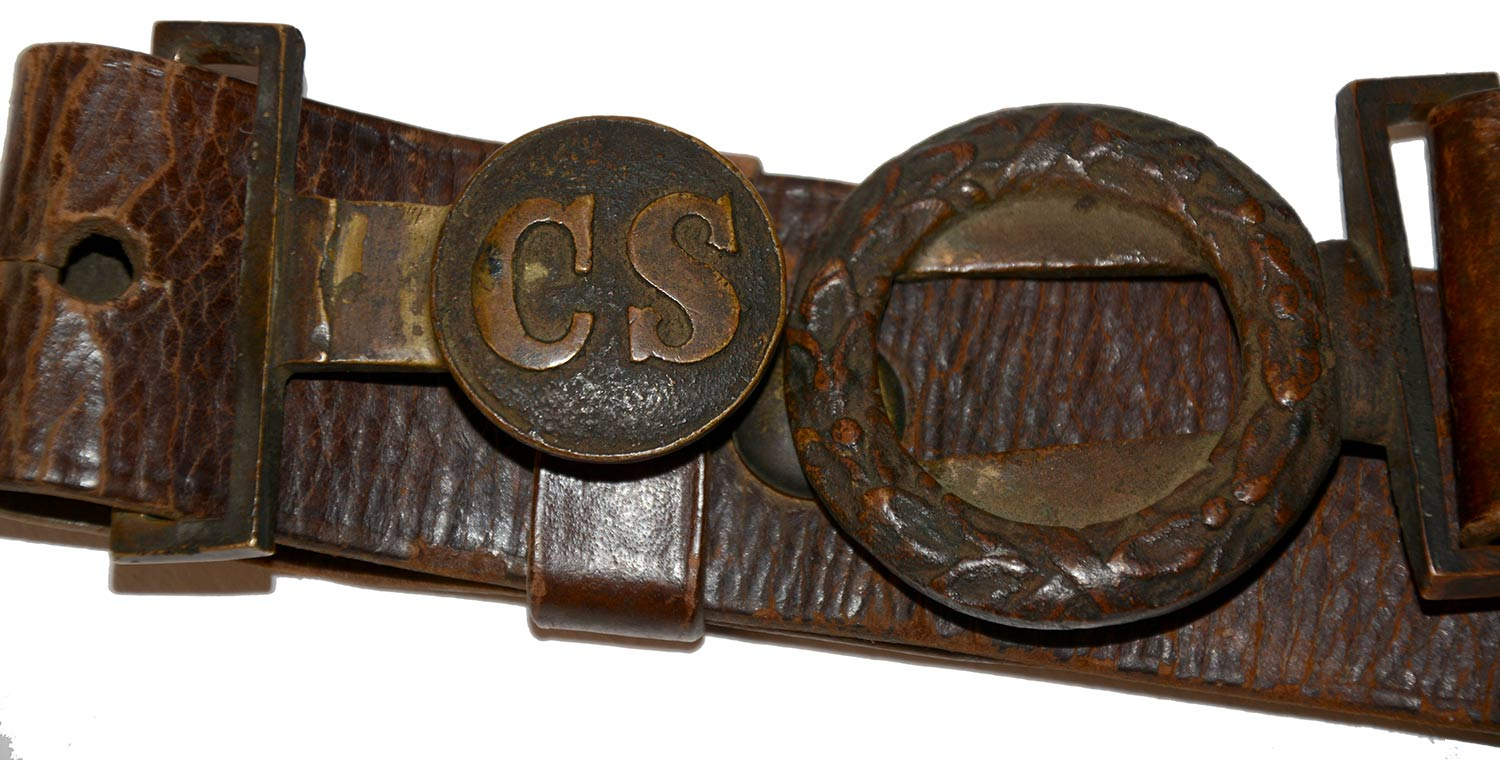
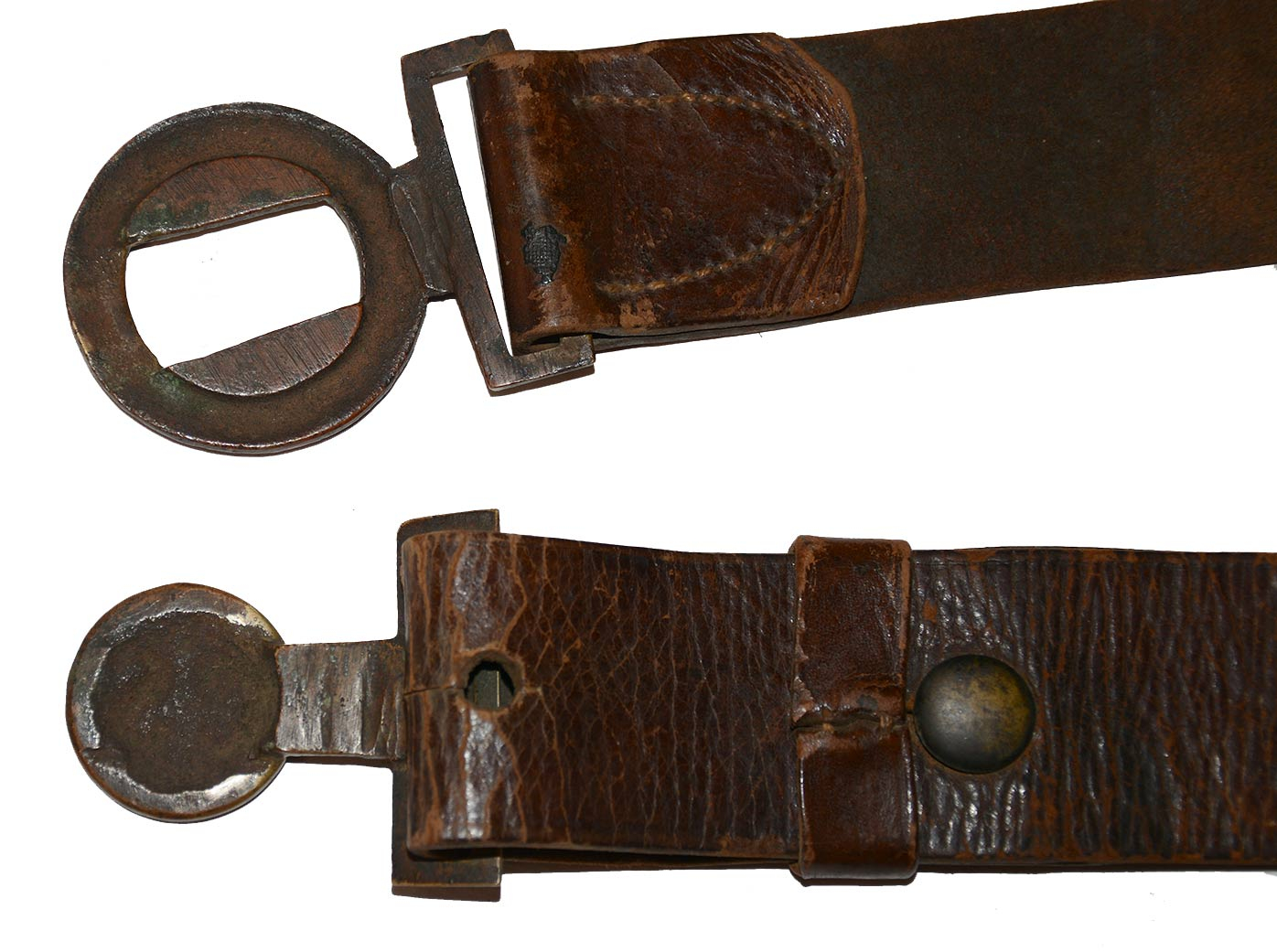
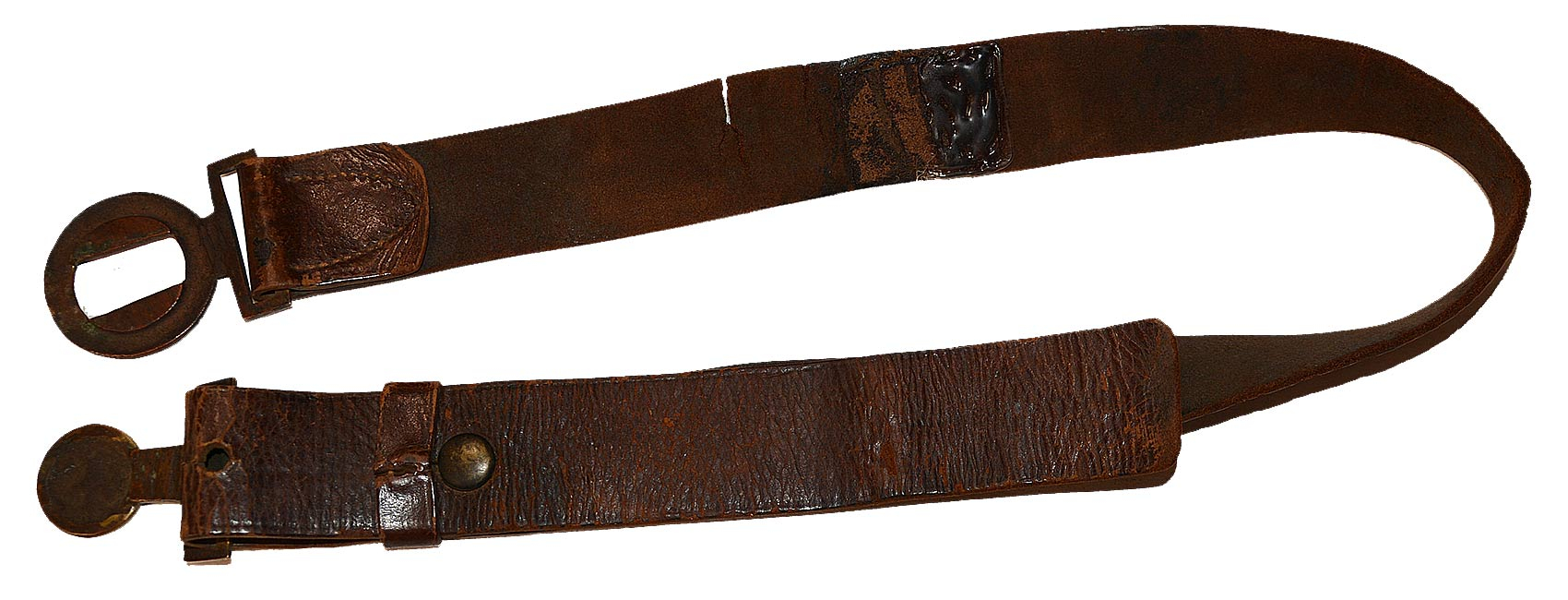
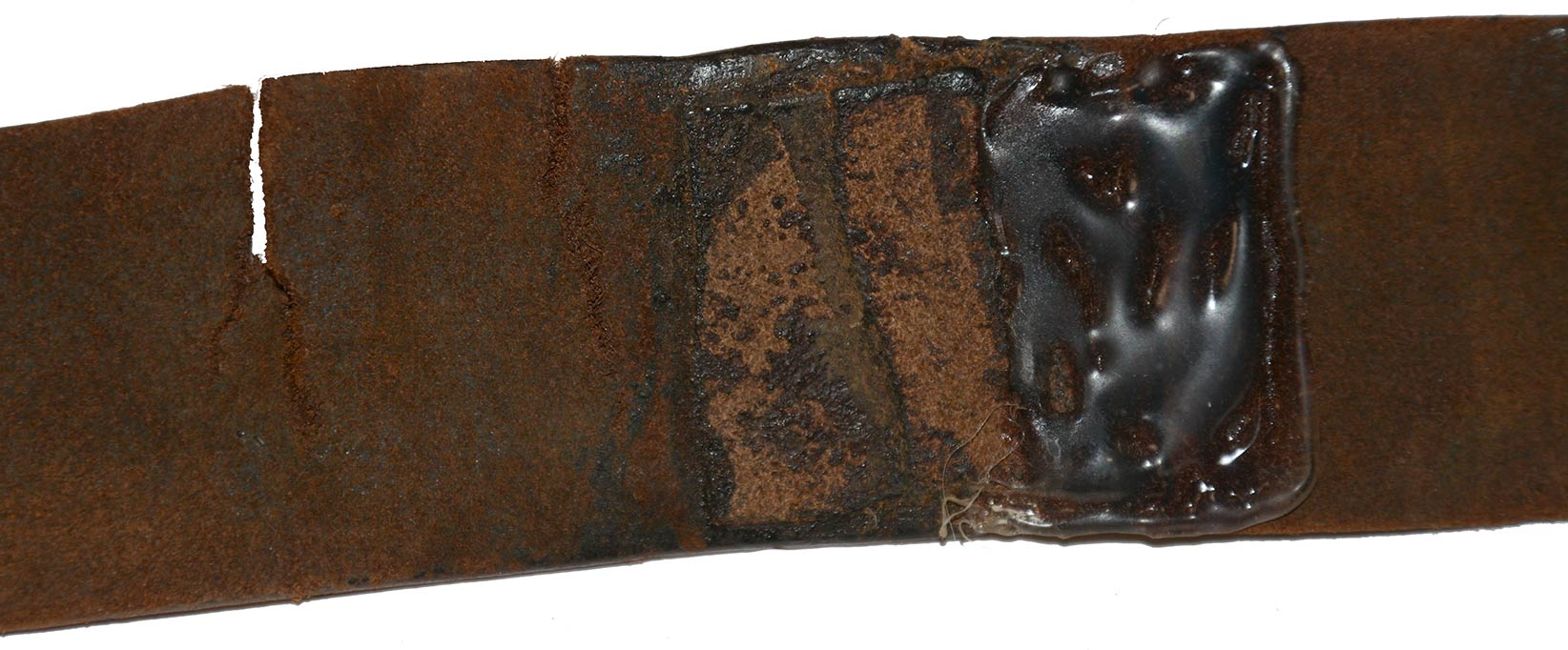
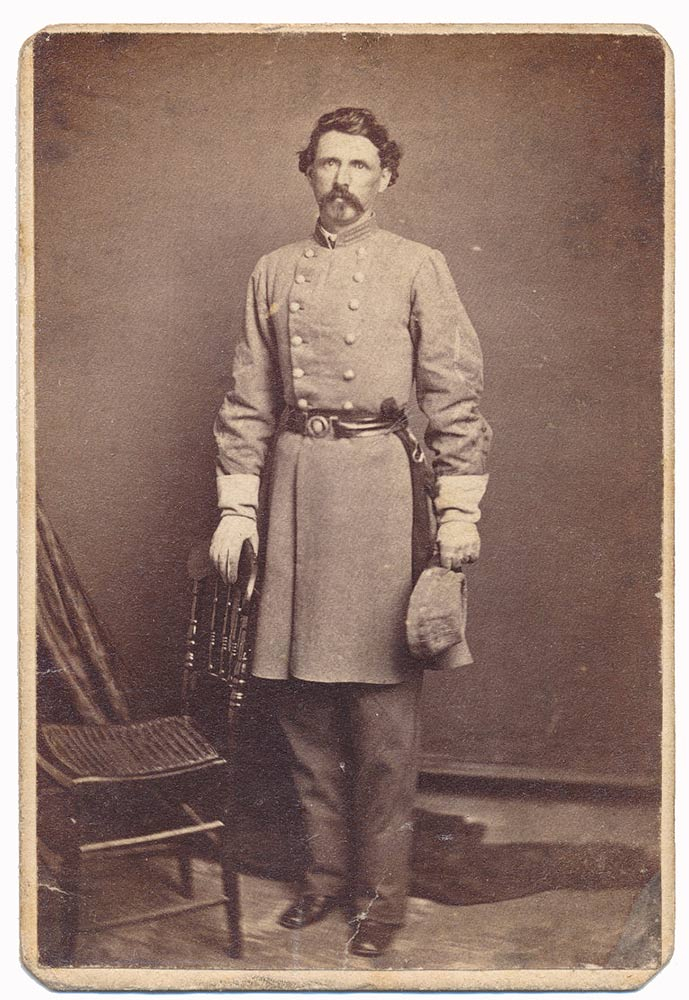
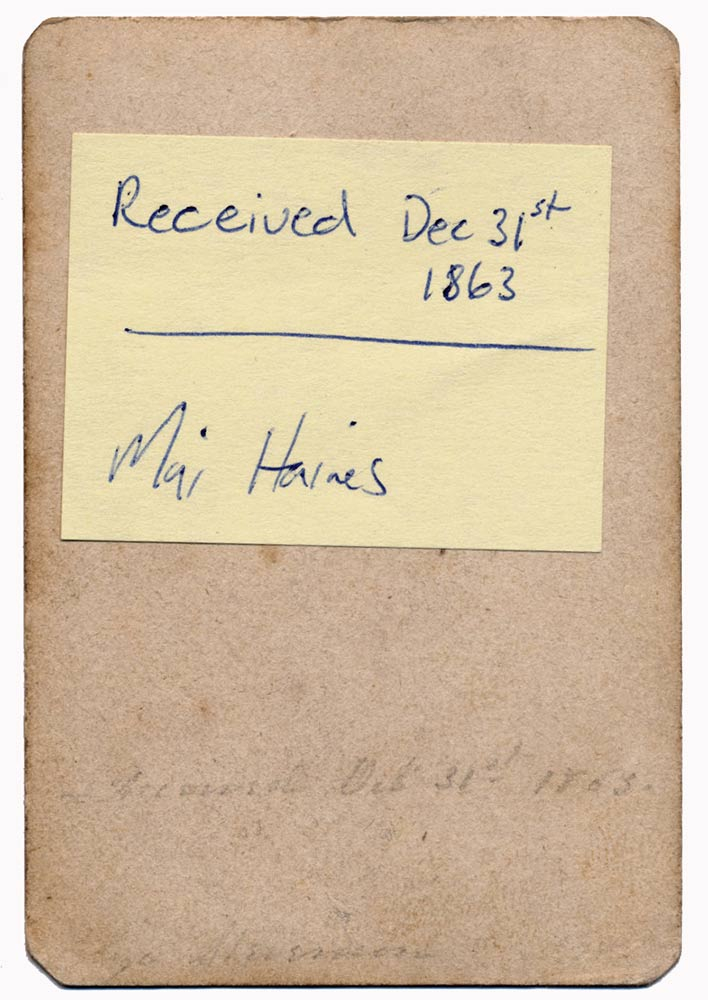
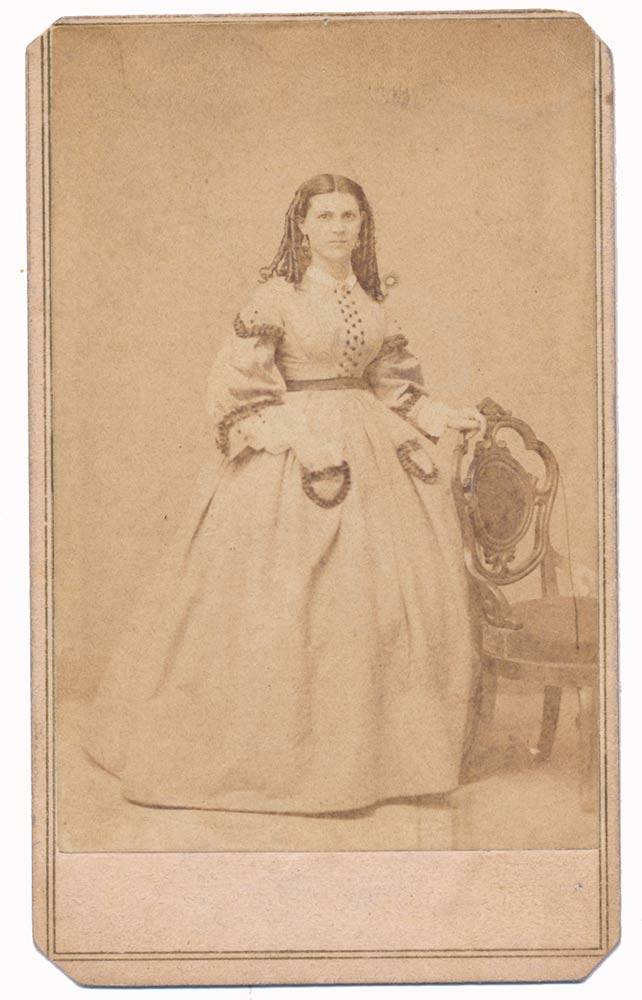
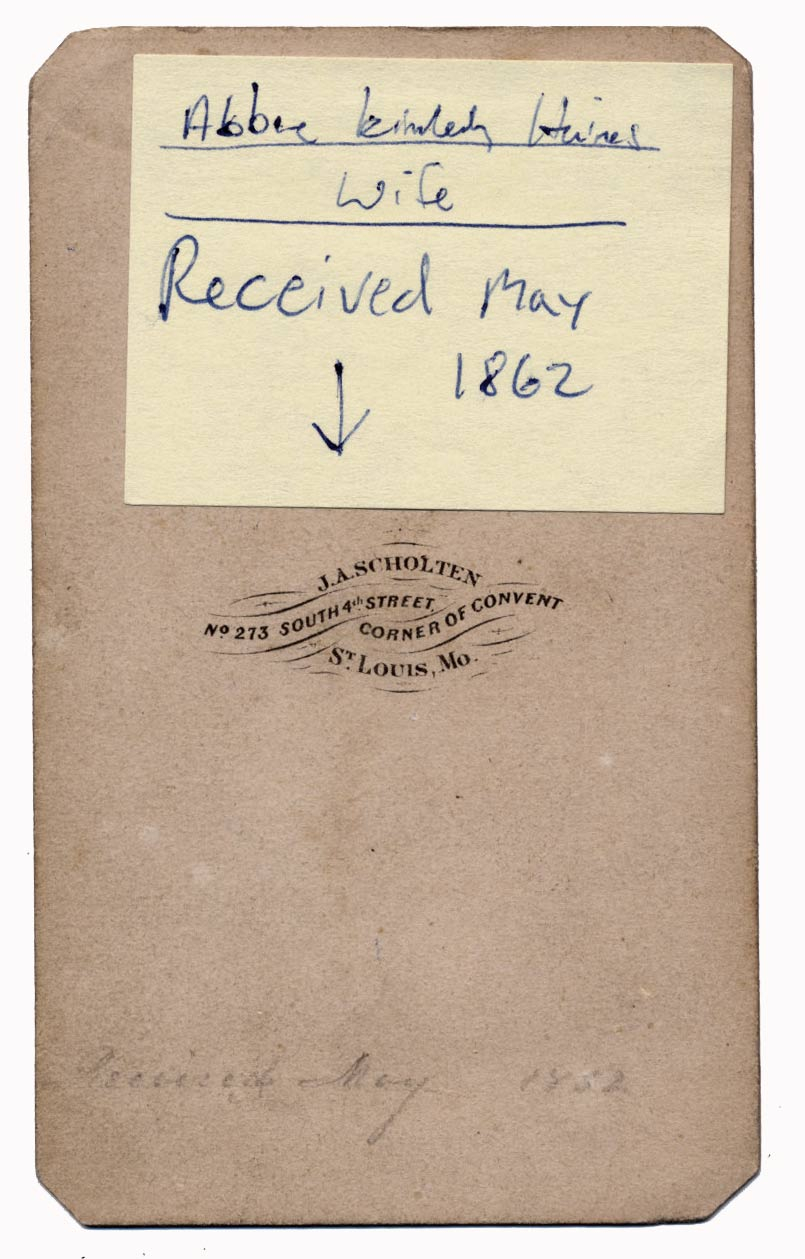
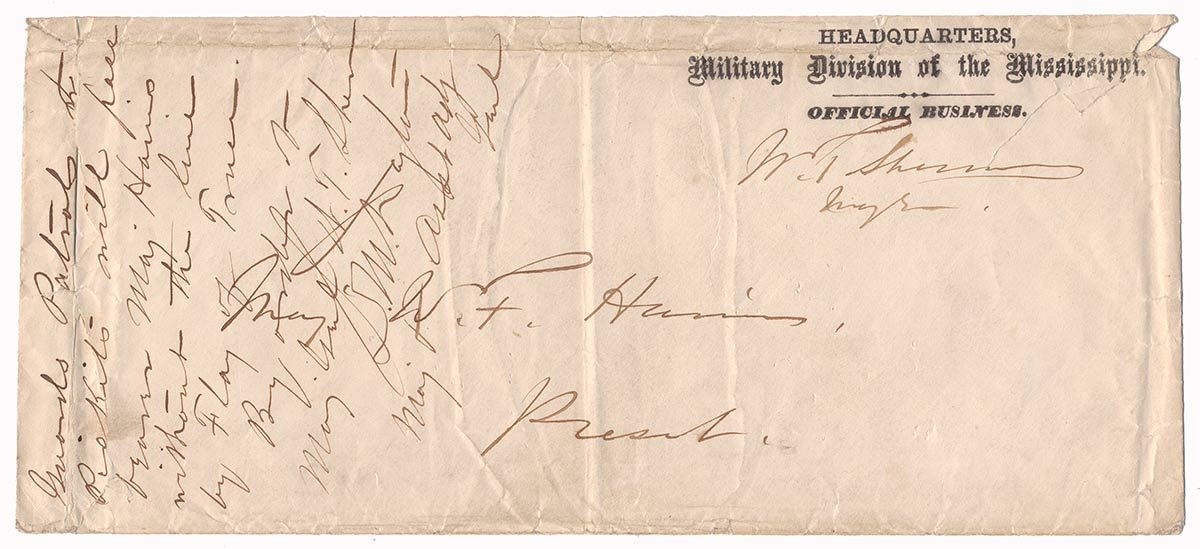
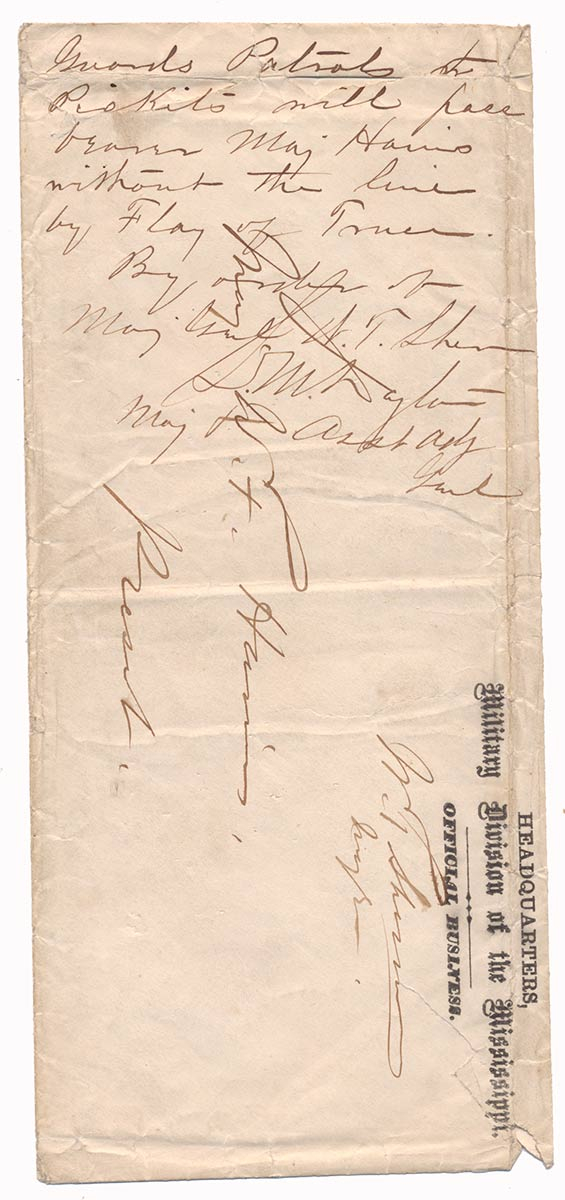
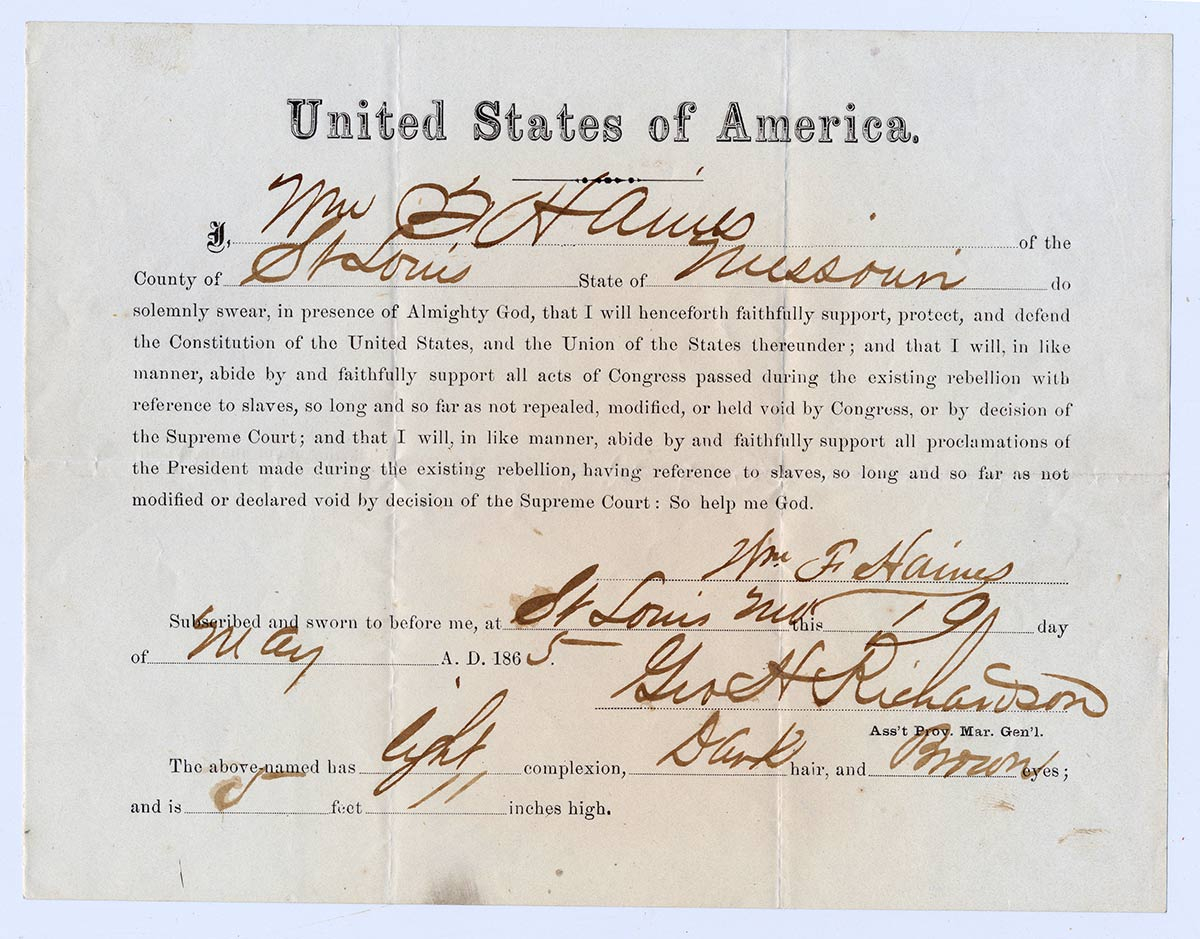
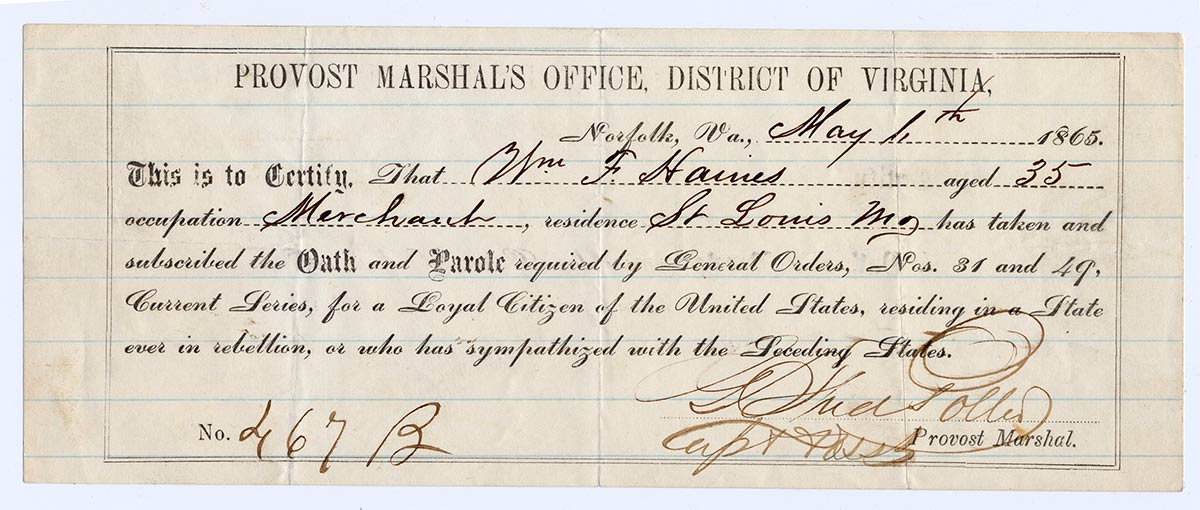
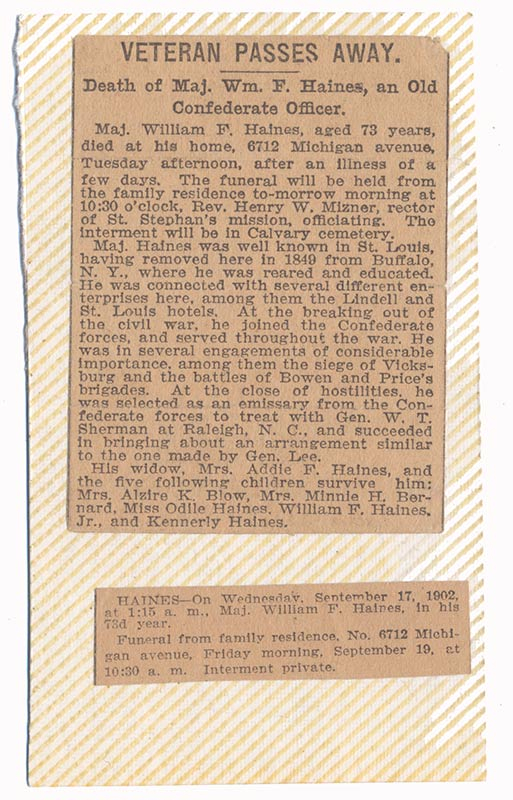
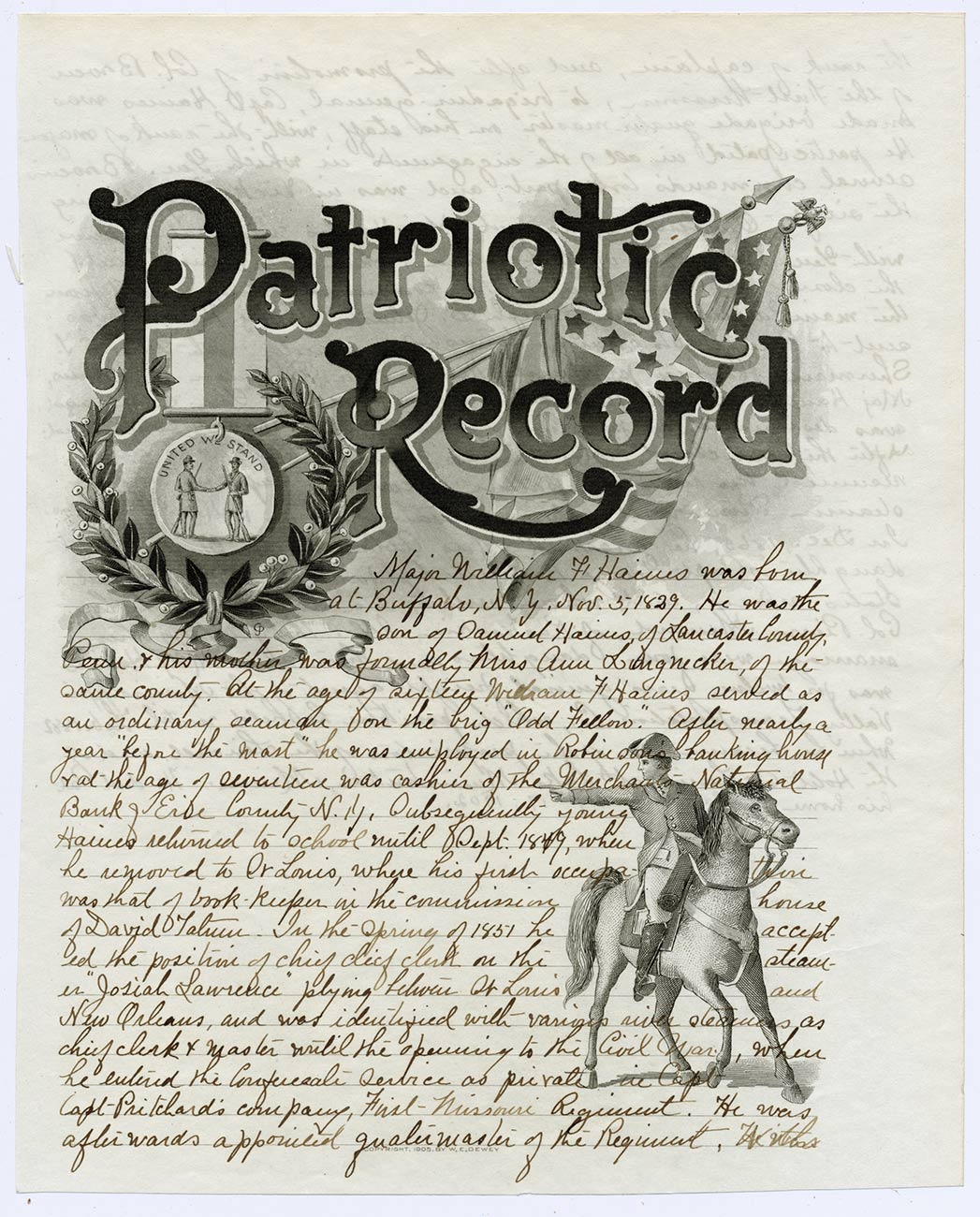
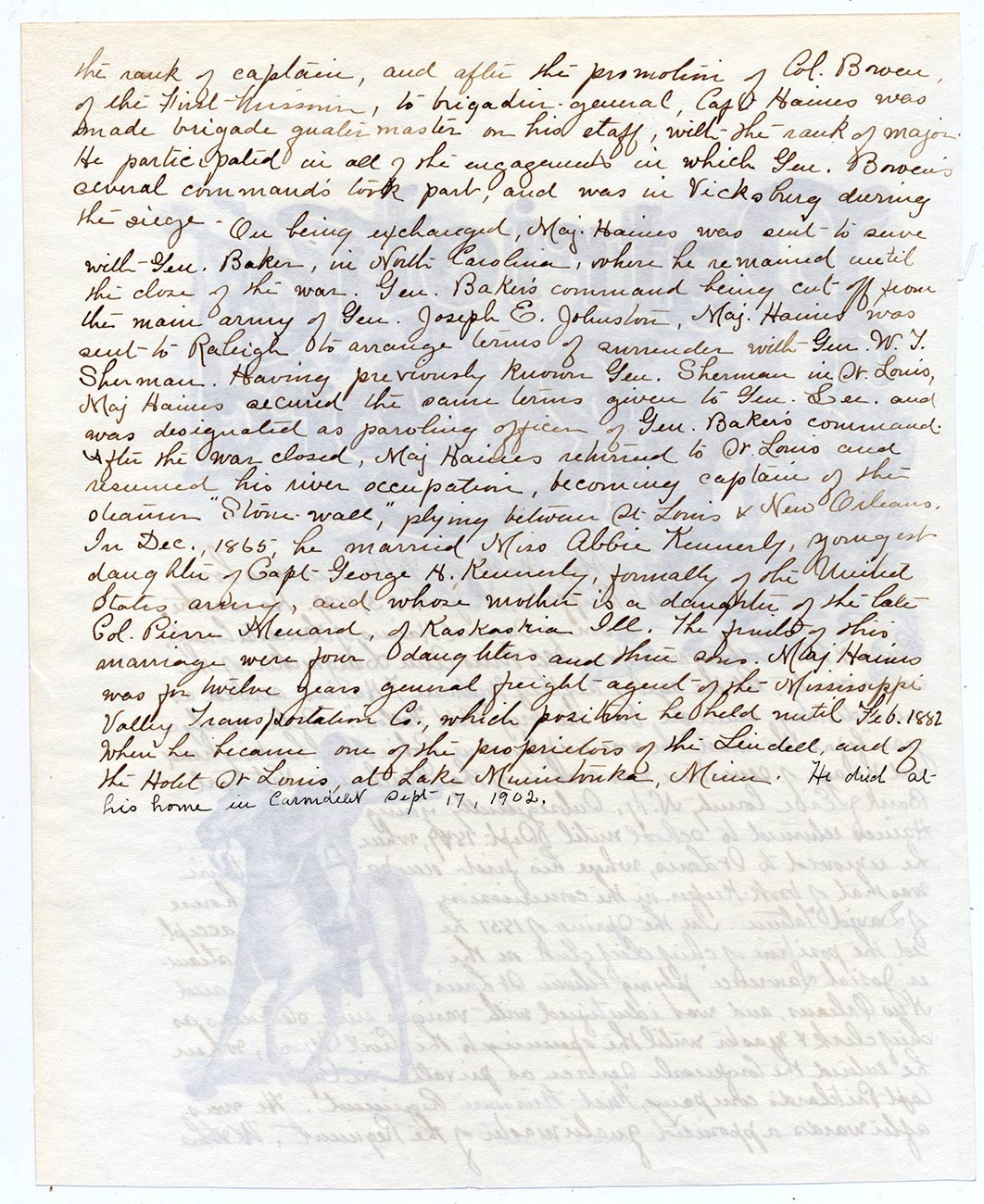
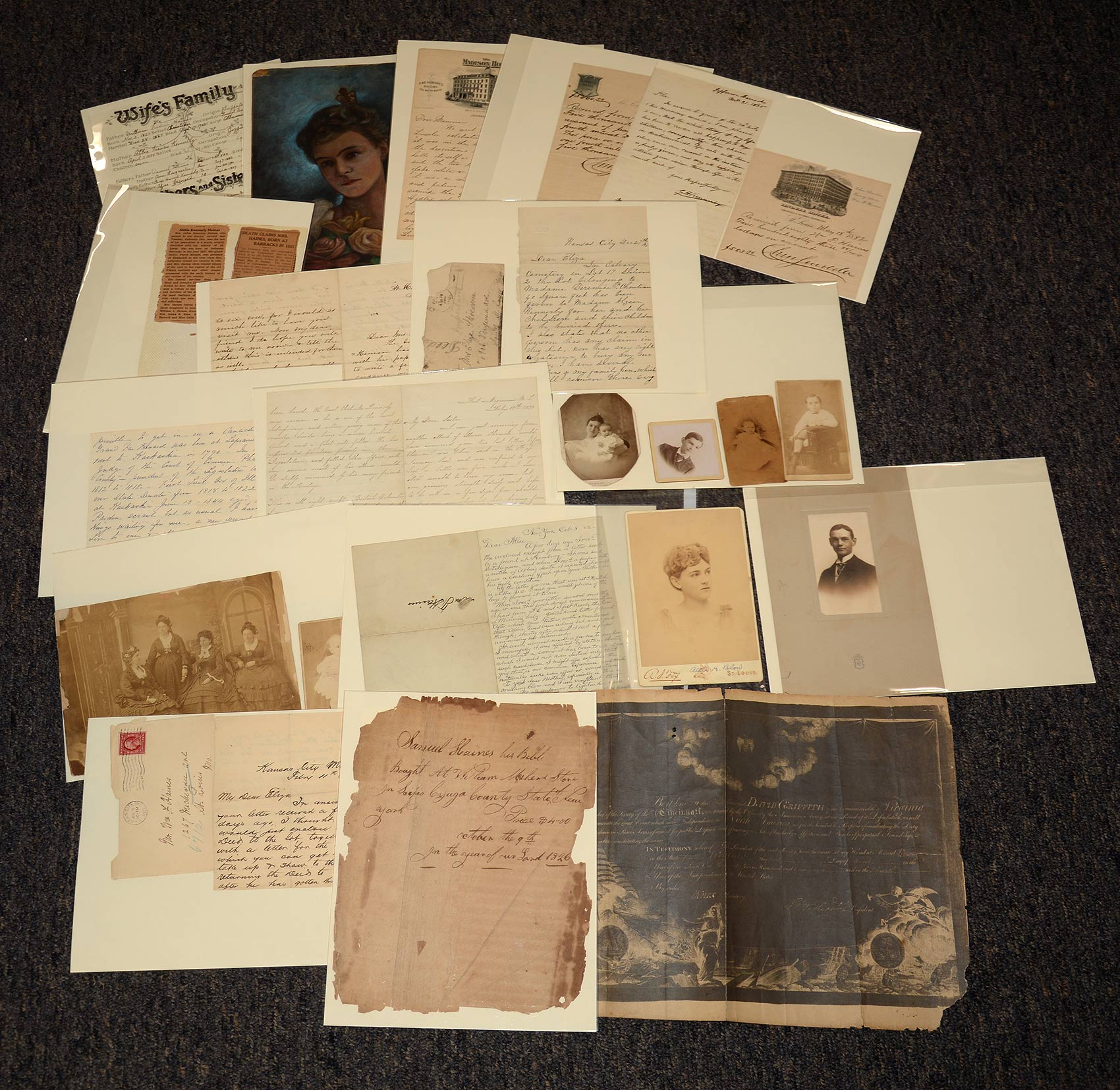
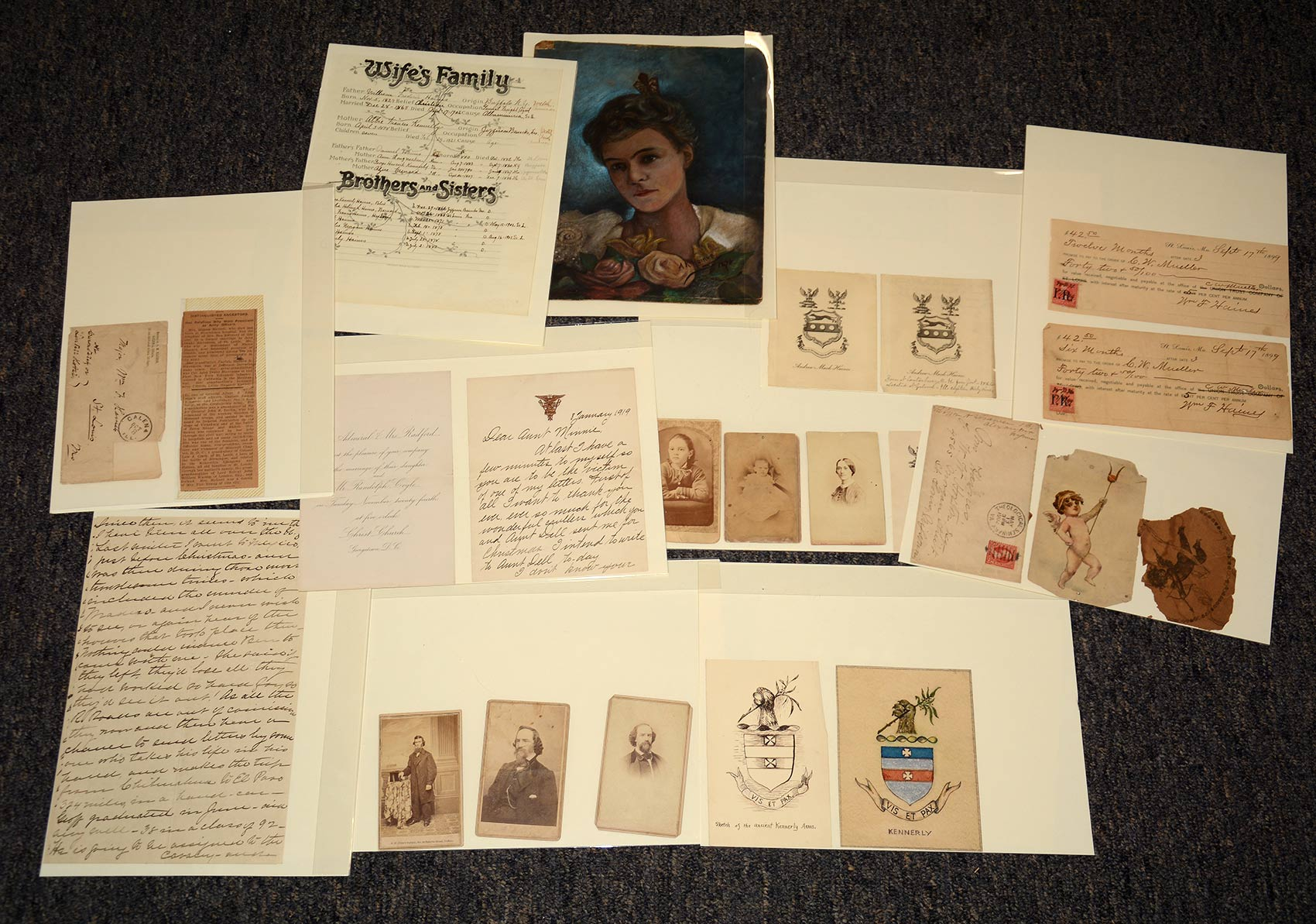
$75,000.00 ON HOLD
Quantity Available: 1
Item Code: 1179-277
This beautiful, identified Confederate major’s coat, sash, sword belt, sash, and holster, once in the Texas Civil War Museum, comes with two brown ink notes that were pinned to it, one reading: “Major W. F. Haines / Bowens Staff / Confederate Army 1861;” and the other: “Major Haines Confederacy / 1861 – 1865.” Accompanying the coat is Haines’ sash, sword belt with interlocking CS plate, pistol holster, and a substantial family archive of photographs, letters, newspaper clippings, obituaries, etc., including a CDV of him in his CS Captain’s uniform. Haines previously served as Quartermaster of the 1st Missouri (CS) and as Brigade QM for Gen. J.S. Bowen, a fellow Missourian and potential brother-in-law, and had seen action at Shiloh and been captured with Bowen’s command at Vicksburg. From June 1864 he was Chief Quartermaster of the 2nd District Department of North Carolina and Southern Virginia under Gen. L. S. Baker, who saw action in keeping vital supply lines open north from Weldon, NC, to Petersburg and Richmond, in attempting to thwart Sherman at Savannah and federal approaches to New Berne in 1865, and a vain attempt to reach Johnston’s army. According to an 1883 history of St. Louis, a handwritten “patriotic record” included with Haines’s effects, and supported by the memoir of a soldier present at the time and a document included in the archive, “Gen. Baker’s command being cut off from the main army of Gen. Joseph E. Johnston, Maj. Haines was sent to Raleigh to arrange terms of surrender with Gen. W.T. Sherman. Having previously known Gen. Sherman in St. Louis, Maj. Haines secured the same terms given to Gen. Lee, and was designated as paroling officer of Gen. Baker’s command.” The coat shows signs of late war manufacture, according to textile authority Les Jensen, and is thus likely the one Haines wore in those personal negotiations with Sherman, which awkwardly took place between the signing of Sherman and Johnston’s “memorandum” of April 18, 1865, which was ultimately rejected, and Johnston’s actual surrender on April 26. The two men nevertheless arrived at a mutually agreeable, unique solution.
Confederate uniforms are rare and field-grade officer’s coats exceedingly so. This one has the added attraction of great condition and a rock-solid identification to an officer from Missouri, the quintessential border state with divided loyalties, Haines himself being born in New York, but becoming a self-made man in St. Louis in the 1850s and throwing in his lot with the state’s pro-southern faction, making his way to Memphis, Tennessee, to enlist in July 1861, and gaining a commission through his strong business and commercial background, and some impressive social connections.
Haines’s coat comes with a 1998 letter of authenticity and analysis by Confederate uniform and textile authority Les Jensen, whose report we borrow from extensively in the following. The coat is in excellent condition, solid, with strong color, and just scattered small moth holes that need no repair for conservation or appearance. The only sizable missing fragment we see is a 1-inch square on the edge of the unhemmed skirt on the wearer’s right. The only seam opening is a small section at sleeve top on the wearer’s left shoulder that could be closed. The coat is dark gray wool, double breasted with seven US staff buttons in each row on the chest. The standing collar rises to 1 5/8 inches at its tallest and is piped with a narrow rolled buff or white material along its upper edge. A single star made of silver metallic braid on a dark blue or black background and measuring about 1 1/8 inch is tacked to either side of collar indicating the rank of major. The edge of the coat is piped with a buff or white 1/8 inch wide rolled cloth border like that on the collar. The sleeves are typically wide for the period, about 10 inches at the elbows and the cuffs much narrower, about 5 ¾ inches, non-functional, each with three small US staff buttons, and bearing a similar piping, but unrolled and ½ inch wide running around the back of the cuff about 2 inches above the bottom and rising as an inverted chevron or pointed cuff to about 3 ½ inches on the outward side. Running over that stripe are flat strands of gold braid, each 3/16 inch wide, originally three strands on each sleeve indicating a field officer, but with one now missing from the left. These rise above the cuff chevron to form regulation galloons or “Austrian knots,” with two narrow loops at the bottom, overlapping larger circles at the midpoint, and tall pointed loop at the top, extending just above the elbow on each sleeve. The rear of the coat is cut in the conventional style with false pockets on the skirts with flaps piped in white, like the front of the coat, lined in brown cotton with a white dot and star pattern on the underside. Two buttons are missing from the rear waist, but the two marking the ends of the pocket flaps are present and are US staff buttons like the others on the coat (all are a mix of “Extra Quality” and “Superior Quality” back marks.)
The sleeves are lined in a white cotton as are the actual skirt pockets, accessible from the inside. The body is lined with a reddish light brown cotton that retains portions of its original glazed surface, and is interlined. There is a patch pocket sewn to the lining of the breast on each side, of brown fabric and clearly added after the coat was made. The front portions of the body have the same lining, pieced in places, and tailored to form a fashionable projecting breast and narrow waist. The skirt is lined with a greenish-black wool/silk material, pleated and tacked at the front for a better fit, and the skirt is pieced in back with triangles at each side of the vent.
Jensen notes that the coat uses materials that are not the best 19th Century quality and some sign of thrift in the piecing of the breast lining, etc., but that the tailoring and production are high quality, the combination indicating a late war product and a scarcity of resources- either on the tailor’s part or Haines’s. Haines made major in 1862, but this would fit with a uniform made after his transfer to the Department of North Carolina and Southern Virginia in June 1864, where he was posted to the end of the war. The notes identifying the coat were pinned to the breast pockets inside.
Haines’s sword belt is brown leather 1 ¼ inches wide with a narrow, impressed border and carries a two-piece interlocking C.S. belt plate in the Richmond style with straight serifs on nicely formed letters on a stippled background with a narrow border on the tongue disk with a sharp step up to the bar and beveled edges to the loops. The plate is in excellent condition with a nice, untouched patina. The belt shows minor wears spots and wrinkles from flexing and has a partial tear that should be repaired or stabilized about five inches from the wreath end of the belt and a glued patch repair on the interior about two inches behind that. The leather is supple, with smooth surface and good color. The wreath portion of the belt plate is sewn in place with typical Confederate bullet-shaped stitching. The loose end runs back through the side loop of the CS tongue and is adjusted by simple double-ended brass stud like those used on a saber slings, and has a single sliding loop. Stitching holes show that it once had sword slings sewn in place on the wearer’s left. The forward sling, likely with a carrying hook, was sewn in place with rectangle of stitching. The rear sling was attached with a vertical oval with pointed ends. No preservatives, polish, or leather dressing has been applied to the leather and the patina of the plate is untouched.
Haines’s pistol holster is black leather shading slightly toward brown. Very good condition. Narrow military flap with separate latch tab sewn with bullet shaped stitching and secured by friction through a standing loop on the body. Narrow belt loop 1 inch wide sewn on the reverse with about a 2 inch opening for the belt. No toe plug and no signs of there being one. Finish is very good. Some minor wear to tab and wrinkling to the flap from flexing. Configured to be worn with butt to the rear. Seam is open about 1 ¾ inches from top, with some scuffing, but no leather is missing. There is a narrow impressed border around the toe, but there is no toe plug, and no sign of stitching, but it may well have been blind stitched. The holster still bears the impression of the revolver’s cylinder and measures about 7 ¼ inches from that impression to the toe, indicating a revolver with barrel of 7 inches or less. No polish, dressing or preservatives have been applied to the leather.
Haines’s sash is the standard crimson silk sash of the period with knots and tassels over wood forms at the ends. It is in fair to good condition with no breaks, but scattered holes and runs, shifting somewhat toward maroon in color. The knots show fading more to red, with wear spots and some loose or missing strands wrapping the tops, but the tassels in place, but it is still very displayable.
We catalog the archive below, but its highlights include period CDVs of Haines and his future wife, both with wartime pencil notes on the reverse dating their receipt, apparently by one of her sisters, indicating his connection with the family before their marriage in December 1865. Haines is shown full-standing in officer’s coat with captain’s bars clearly visible on his collar, wearing sash, belt, and gauntlets, holding his cap at his side.
William Frederick Haines was something of a self-made man and combined a sense of adventure with solid business sense. Born in Buffalo, NY, in 1829, he signed on to the brig “Odd Fellow” at age sixteen, spent a year as an ordinary seaman, and then returned to short to take a job as a cashier at the Merchants National Bank of Erie County at age seventeen. He returned to school for a time, but then headed west in 1849, settling at St. Louis, where he became a book-keeper at a “commission house,” and in Spring 1851 combined his administrative and nautical talents to become chief clerk on the steamer “Joshua Lawrence,” running between St. Louis and New Orleans, and worked both chief clerk and as master on other river steamers until the beginning of the war. He also seems to have purchased partial interests in various businesses. We find him connected with a liquor store before the war and after the war, in addition to becoming captain of the steamer “Stonewall” and working as freight agent, he purchased an interest in a partnership running a hotel in St. Louis and another on Lake Minnetonka in Minnesota.
A history of St. Louis says he entered Confederate service as a private in the 1st Missouri (CS,) but Confederate records pick him first as enlisting one year in the 1st Missouri on June 27 at Memphis at age 30, listing himself as a steamboat clerk. The service as a private may simply be cover the period between his enlistment and gaining a commission as Captain and Acting Quartermaster, officially dating to July 10, 1861. The regiment organized at Memphis under Col. John S. Bowen, with whom Haines was closely linked until Bowen’s death from disease in July 1863. The two certainly knew one another socially. Haines would eventually marry a sister of Bowen’s wife. The regiment’s officer corps was certainly close knit: three of her brothers were also in it.
Haines remained regimental quartermaster until May 1862, though occasionally referred to as a brigade and division quartermaster, likely temporary assignments for troops in camp. He is credited in his records with service at Shiloh and was present in the subsequent campaigning around Corinth. Bowen had been promoted to brigadier general in March and obtained Bowen’s transfer to his staff as brigade quartermaster with the rank of Major in May. The brigade was assigned to Vicksburg in summer 1862 and in October was part of the Army of West Tennessee and fought at the Second Battle of Corinth. In the Vicksburg campaign of 1863 Bowen fought well at Port Gibson, receiving a promotion to Major General and command of a division soon after, fighting at Champion Hill, and successfully repelled Union assaults at Vicksburg, but taken prisoner with the garrison in July, and succumbing to disease just several weeks later.
Haines, too, was captured and paroled at Vicksburg and after exchange transferred in the Fall to the Pay Branch of the Quartermaster Department, and later was posted to Adjutant and Inspector General’s office, where he was responsible for inspecting accounts and was then put in charge of the government repair shops of the Army of Tennessee in Georgia in December 1863 until June 1864 when his service was requested Chief Quartermaster of the Second District of the Department of North Carolina and Southern Virginia by General L.S. Baker, a fighting North Carolina cavalry officer posted to that position after being severely wounded.
Baker commanded different bodies of troops at various times, including the North Carolina Junior Reserves Brigade, being called upon to move toward Savannah at one point to counter Sherman and at another moving to block a Federal advance near New Bern. In March 1865 he had about 500 men under his command, headquartered at Weldon, a key point along the vital supply line north to Lee’s forces at Petersburg and Richmond. The situation was hardly restful. Baker’s papers show he was faced by threats both by land and by water and J.M. Mullen, a soldier in his command noted Baker was frequently required to visit other posts under his supervision. In March and early April he had already launched two different expeditions to deal with Union cavalry busily tearing up rail lines.
Faced with Sherman’s advance into North Carolina, Baker ordered his troops to pull out on April 12 and link up with Johnston. Baker and his staff, which would have included Haines, joined them on the road on April 14. Baker waffled in his plans, at first proposing to surrender under the terms offered to Lee, whose paroled soldiers they began encountering on the roads, then deciding to circle Sherman to join Johnston, only to decide on the night of April 16 to “cut his way through to Johnston with all would volunteer to follow him” (Mullen.) That force amounted to just fifty, mounted on government horses and armed with Enfield rifles. After marching for two days, however, and hearing that Johnston had surrendered Baker reverted to his previous plan, deciding on the evening of April 18 “to send in a flag of truce to Raleigh, tendering his surrender.” Baker sent out the flag on April 19, “the officer in charge” bearing a letter.
That Haines was that officer is clear from an envelope preserved in the family archive and offered with this group. It has a preprinted return or originating address at upper right reading, “HEADQUARTERS, / MILITARY DIVISION OF THE MISSISSIPPI / OFFICIAL BUSINESS,” and signed just below: “W.T. Sherman / Maj. Genl.” The envelope is addressed, “Maj. W.F. Haines / Present,” indicating it was handed to Haines in person (for parallels for this address, see correspondence quoted by Sherman in his memoirs, Vol. 2.) Written across the envelope at the left side is: “Guards Patrols & Pickets will pass bearer Maj. Haines without the line by Flag of Truce. By order of Maj. Genl. Sherman / L.M. Dayton Maj. & Asst. Adj. Genl.”
This clearly was to enable Haines to go back through Sherman’s lines with his response to Baker. It also likely contained the pass for Haines dated that very day, April 19, 1865, and personally written by Sherman, that was sold at RR Auctions in 2012 and again at Heritage Auctions in 2014. Written on letterhead reading “HEADQUARTERS, MILITARY DIVISION OF THE MISSISSIPPI,” matching the envelope still in the archive. That letter read, "Major W. F. Haines of Gen Bakers [mistakenly read as “Bowens” by the cataloger] staff, a parolled officer with a servant & mule has permission to travel with his horse and personal Baggage to any place within our Lines. En route to his home in Missouri/ W.T. Sherman / Maj Gen Comd.”
This securely places Haines at Sherman’s headquarters and, being completely in Sherman’s hand, supports some personal connection between the two men. Haines and Sherman overlapped in St. Louis when Sherman was posted there in 1851-1852 while on duty with the Commissary Department, and again in 1861 when Sherman was taking up a banking position in the city. Haines’s business interests were wide enough to have brought them in contact or make it likely they had friends in common. The immediate situation may also have forged a connection or understanding. Sherman was desperately concerned to avoid having armed bands of dispersed Confederate soldiers roaming the country and engaging in guerrilla warfare, a concern that likely resonated with Haines since Missouri hosted the most widespread, prolonged and destructive guerrilla fighting of the war.
The unexpected problem facing them both was that in the letter delivered by Haines Baker mistakenly thought Johnston had already surrendered and asked for the same terms since his command was part of that army: “Finding that General Johnston has surrendered his army, of which my command forms a part, I have the honor to surrender my command, with a request that the same terms be allowed me as were allowed to General Johnston’s army…” Johnston and Sherman, however, had only signed a “memorandum” on April 18 and were waiting for the terms to be approved in Washington, which ultimately were not. The two armies were actually facing one another in a temporary truce that could be broken with 48-hours notice by either party. Baker’s contingent was hardly a military threat to Sherman, but this was exactly the type of small armed band Sherman wanted to prevent causing problems and Haines likely made clear that holding them together until Johnston finally surrendered was unlikely- some nine-tenths had already dispersed.
In an arrangement apparently hammered out with Sherman Haines returned to Baker with the news that Johnston had not surrendered, a copy of the July 18 memorandum, but also a letter that, “gave Baker the right to disband his force under the terms granted to Lee’s army.” These, of course, were the terms first envisaged by Baker, and his men were clearly eager to go home so it was a satisfactory offer. It also worked to Sherman’s advantage since Lee’s terms involved paroling the men, not merely letting them disperse, and giving up their government arms, making Haines’s designation as “paroling officer” more significant as a sign of understanding and trust by Sherman since in theory it should have been performed by a Union officer.
Mullen quotes the document supplied by Baker to each of his men, which does not use the word “parole,” but functions as one: “In accordance with an agreement with Major-General Sherman, commanding United States forces in North Carolina, Private [……….] is permitted to go to his home, and there quietly remain, taking with him one horse, private property.” (Mullen jokes that being allowed to take the horse as private property was the best army pay he had ever received.) Haines also seems to have compiled a full list of the men covered by the agreement and also supervised the surrender of their arms, if not to Union authorities at least to civilian control. Both Mullen’s and Haines’s own service records include a note that their names appear, “on a Roll of officers and men paroled and sent home in pursuance of an agreement with Maj. Gen’l Sherman, Comdg. U.S. forces in N.C. Arms of non-com’d officers and privates turned over to B.T. Strickland, Wakefield, N.C., citizen. Roll dated Headquarters 2d Mil. Dist., Dept. N.C., Bunn’s House, April 20, 1865.”
Haines returned to St. Louis to marry Abigail Kennerly in December 1865 and rear seven children, five of whom, with his wife, survived him in September 1902. As with the city history and his “patriotic record,” an obituary made prominent mention of his Confederate service, particularly in the final days of war: “At the close of hostilities he was selected as an emissary from the Confederate forces to treat with Gen. W.T. Sherman at Raleigh, N.C., and succeeded in bringing about an arrangement similar to the one made by Gen. Lee.” That notice avoids the word “surrender,” but like the other references implies he somehow managed to get better terms from Sherman when it seems his real success was in getting a workable “arrangement” or “agreement” that would end the fighting at all.
***
MATERIAL IN THE ARCHIVE
Pass written on envelope from Headquarters Military Division of the Mississippi with W.T. Sherman signature, addressed to “Maj. W. F. Haines / Present.” “Guards Patrols & Pickets will pass bearer Maj. Haines without the line by Flag of Truce. By order of Maj. Genl. Sherman / L.M. Dayton Maj. & Asst. Adj. Genl.
Original CDVs of Haines in CS uniform, pencil note reverse “Received Dec. 31st 1863, faint pencil on bottom “Alize” or “Eliza Stevenson.” Id’d by modern note as Maj. Haines. CDV young woman “Received May 1862” id’d modern note as Abbie Kennerly Haines. Eliza Clark Kennerly Stevenson was the sister of Haines’s future wife. The 1863 date is a nice confirmation of his connection with the family even before his marriage.
May 19, 1865, oath of Allegiance by Wm. F. Haines at St. Louis.
Receipt of oath of allegiance for Wm. F. Haines, May 6th 1865 Provost Marshal’s Office, District of Virginia Official Business
11/21/65 from Jefferson Barracks to Maj. W.F. Haines from GH Kennerly, giving consent to marrying his daughter (leaving it up to her.)
Letter to Alziere Kennerly Blow with her notice in Woman’s Who’s Who of America.
Oil on board portrait of a woman, 8 x 10, inscribed “AK Haines 1896” lower right.
2/3/70 letter from San Antonio TX, signed Bro Peter to Dear Bro, ref to Henry in Montana heading to gold fields, division of property concern for their dear Ma. Says the QM Genl was there and would arrange things in Washington to his satisfaction.
1882 hotel receipt Lindell Hotel Association, Scudder, Ames, and Wm. F. Haines.
Two bookplates of Andrew Mack Haines. One with pen note born Canterbury NH 1820, removed to Galena Ill 1839.
Two 1899 cancelled St. Louis checks of Wm. F. Haines.
2/16/1882 receipt from Scudder and Ames $5,000 to Haines on ¼ interest in the Lindell Hotel for $25,000.
Letter to Dear Mamma from M…? on Madison Hotel, Jefferson City MO stationery about Lincoln celebration at the capitol.
July 1869 letter from St. Louis of WF Haines to wife, apparently in Illinois, telling her not to come and bring children, hot weather has made it sickly with high death rate “under five years,” ref to children.
Two cards with drawings of the Kennerly arms.
1902 letter from SH Haines to Dear Allie, regarding news of deaths in her family in St. Louis.
1886 letter from Berenice Chouteau of Kansas City to Eliza Stevenson of St. Louis regarding cemetery plot.
1887 letter from Berenice Chouteau to Dear Eliza regarding cemetery plot.
Envelope dated 1911 to Mrs. Wm. F. Haines
Envelope to Mrs. Haines, St. Louis from Alexandria, VA. Two clipped newspaper cupids, one black.
Bookplate of Andrew Mack Kennerly, CDVs Allie Haines as baby and as young girl, CDV Frances E. Haines, CDV Bud Haines, Allie Haines as baby, Unid young man (Bud Haines?), photo Abbie Haines Hoxton (?) & her son Llewellyn Hoxton.
Xeroxes of CW CDVs of Haines, his wife, his obit.
Photo unid man ca 1900.
Cabinet card of “Allie H. Blow” ink ownership note on back Mrs. Wm. F. Haines
CDV baby “Charlie Haines” on reverse. Large photo four women in studio, id’d on xerox copy as “the Kennerly women of St. Louis descendants of Pierre Menard” (both 1870s)
CDV Buffalo NY 1860s pencil id rev Samuel Haines 1800-1882
Front page from Samuel Haines bible with note of purchase 1826.
Old photocopy Soc. Cinc. Diploma for David Griffith of VA.
CDV older man Buffalo NY BM (poss Samuel Haines) CDV young woman, St. Louis imprint, photo young man in uniform ca. 1905
CDV young woman, St. Louis imprint, tax stamp, “Abbie Kinnerly Haines” and “1864” , CDV 1870s St. Louis, period pencil id Wm. F. Haines.
Newspaper clipping “Battle of Franklin Fought Thirty-eight years ago to-day.” Story of 1st Missouri CS in the battle. Lt. James Kennerly one of only three officers left on duty after the battle.
Letter to Minnie re: Pierre Menard genealogy.
Letter to Aunt Minnie from Llewellyn at Naval Academy. 1919. Invite to wedding of daughter of Admiral and Mrs. Radford.
Letter 1883 to Mrs. Haines from friend in Mississippi. Envelope from A.M. Haines in Galena Ill. to Maj. Wm. F. Haines, St. Louis.
Letter to Cousin Abbie from Jennie Keys Fort Snelling, ca. 1910. Ref to Geoff graduating 38 in a class of 92 and going into the cavalry, so likely USMA. Letter from Henry Kennerly to sister 1873, mentioning illness, from Ft. Maginnis Montana Territory, seems to have been trader, transcribes newspaper report of his illness and sending medicine to him.
Obit of Mrs. Mijnot Melnott, was a daughter of Mrs. John D. Stevenson.
Two obits of Abbie Kennerly Haines. [sr] [ph:L]
~~~~~~~~~~~~~~~~~~~~~~~~~~~~~~~~~~~
THIS ITEM, AS WITH ALL OTHER ITEMS AVAILABLE ON OUR WEB SITE,
MAY BE PURCHASED THROUGH OUR LAYAWAY PROGRAM.
CLICK HERE FOR OUR POLICIES AND TERMS.
THANK YOU!
Inquire About MISSOURI CONFEDERATE FROCK COAT, SASH, CS SWORD BELT, AND HOLSTER, OF MAJOR WILLIAM F. HAINES, WITH FAMILY ARCHIVE OF PHOTOS & PAPERS: SHILOH, VICKSBURG, AND NEGOTIATIONS WITH SHERMAN FOR SURRENDER OF GEN. L.S. BAKER’S COMMAND IN APRIL 1865
Most Popular
Historical Firearms Stolen From The National Civil War Museum In Harrisburg, Pa »
Theft From Gravesite Of Gen. John Reynolds »
Selection Of Unframed Prints By Don Troiani »
Fine Condition Brass Infantry Bugle Insignia »
Large English Bowie Knife With Sheath 1870’S – 1880’S »
Imported (Clauberg) Us Model 1860 Light Cavalry Officer's Saber »
featured item
CAPTAIN W.W. RANDOLPH: LIKELY WILLIAM WELFORD RANDOLPH, 2nd VIRGINIA, LATER LT. COLONEL, KIA THE WILDERNESS 1864
Identified as Capt. W.W. Randolf (sic) in the files of the late Bill Turner, noted Virginia collector and dealer, this six plate ambrotype shows Randolph seated with one hand on his thigh and the other resting on a book atop a photographer’s table… (1138-1803). Learn More »


